Dienstag, 17. Juli 2018
7. und Letzter / 7th and last
Roadtrip Tag 19 (Dienstag, 12.06.)
Morgens besuchte ich endlich das Museum und der Ort an dem der Vertrag von Waitangi geschlossen wurde. Dieser Vertrag wird als erste Verfassung angesehen und hält das Zusammenleben der Briten und Maori fest. Zum Beispiel: Die Briten schützen die Maori im Ernstfall, die Maori dürfen ihre Länder behalten mit eriner Verkaufsoption. Und noch weitere Details. Er wurde am 6. Februar 1840 unterzeichet. Danach fuhr ich wieder Richtung Süden nach Auckland. Ich buchte mich direkt in ein Hostel ein und verbrachte dort meine letzten zwei Nächte in Neuseeland.
Roadtrip Tag 20 (Mittwoch, 13.06.)
Ich nahm den nächstbesten Bus in die Innenstadt. Dort schlenderte ich durch die Skycity und durch die Queen Street. Die sozugaen das Herz Aucklands bilden. Ich lief auch zum Kai um aufs Wasser zu schauen. Ich hatte einen super Blick auf die Harbor-Bridge. Eines der Wahrzeichen Aucklands. Ich besorgte auch noch die allerletzten Mitbringsel. 2Kg Manuka-Honig, der nur schwer in Deutschland zu bekommen ist. Am späten Nachmittag brachte ich noch einiges zur Heilsarmee und wusch mein Auto. Da ich noch Zeit hatte und es einigermaßen hell war, beschloss ich noch auf den Mount Eden zu wandern, der nur 3 Minuten Fußweg von meinem Hostel entfernt war. Mount Eden ist einer von 48 Vulkanen und auch die höchste natürliche Erhebung Aucklands. Ich genoß die Aussicht und schoss beeindruckende Fotos der Stadt. Auf dem Rückweg gab es zum Abschluss noch einen saftigen Burger.
Roadtrip Tag 21/22 (Donnerstag, 14.06./Freitag 15.06.)
Abreisetag! Ich war etwas zerstreut und in Eile. Ich packte meine restlichen Sachen ein, belud meinen Camper um ihn abzugeben. Als es soweit war, bemerkt ich, dass ich Pingu im Zimmer liegen gelassen hatte. Da aber mein Taxi schon unterwegs war, redete ich mit dem Fahrer, der mich nochmal zurück brachte, dass ich Pingu holen konnte. Endlich am Flughafen angekommen, wollte ich einchecken, als die Dame mir sagte, dass mein Flug 2,5 Stunden Verspätung hatte. Der Verzehrgutschein machte die Wartezeit etwas erträglicher. Doch ich wurde umgebucht, da mein Gepäck den Anschlussflug nicht erreicht hätte. So musste ich ein paar Stunden in HongKong übernachten. Das Zimmer und ein Frühstückgutschein wurden von der Airline bezahlt. Warum also nicht? Morgens (HongKong-Zeit) ging es dann ins Flugzeug nach Helsinki. Ich war so froh endlich wieder auf europäischen Boden zu sein. Von Helsinki ging es dann nach Frankfurt. Da ich ca. 12 Stunden später ankam als erwartet musste ich natürlich ein neues Zugticket kaufen. Gesagt, getan. An diesen Tagen verfolgten mich die Verspätungen. Der ICE hatte auch Verspätung wodurch ich meinen Anschluss in Stuttgart verpasste. Um ca. 23.20 Uhr MESZ saß ich endlich im Zug und war kurz vor 0.00 Uhr zuhause. ENDLICH!
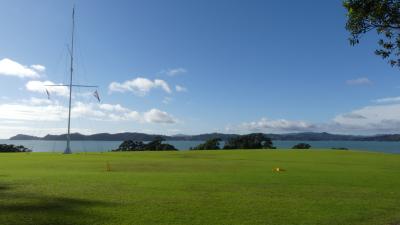
Waitangi
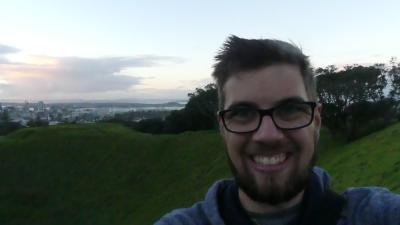
Mount Eden

Auckland
Roadtrip day 19 (Tuesday, 12.06.)
Finally I visited the Treaty Grounds in Waitangi. This treaty is the most important document for New Zealand and it contains the living between Maori and Britains. For example: the britains protect the maori, the maori own their land with the option to sell it and much more. It was signed on the 6th of February 1840. After that I drove south to Auckland. I booked a room in a hostel and stayed my two last nights in New Zealand there.
Roadtrip day 20 (Wednesday, 13.06.)
I took the next bus to the city center. There, I walked through the Skycity and the Queen Street, which are the heart of Auckland. I also wandered to the quay to look on the water. I had an incredible view to the harbor-bridge ´, which is one of the landmarks of Auckland. I also bought the last souvenirs. 2 kg of Manuka-Honey, which is difficult to get in Germany. In the late afternoon, I washed my car and brought some stuff to the salvation army. As I had time and it was still bright, mI took a walk on top of Mount Eden, which was three minutes from my hostel. Mount Eden is one of 48 volcanoes and the highest natural point in Auckland. I enjoyed the view and took breathtaking photos. On my way back I ate a super burger.
Raoadtrip Day 21/22 (Thursday 14.06./Friday 15.06.)
Day of departure! I was silly and in hurry. I packed all the rest I had and loaded all in my camper to bring it back. As it had to come, I realized that I forgot Pingu in my room. The Taxi was already on the way. So I talked to the driver that I can get Pingu from the hostel. Finally as I arrived at the airport, I wanted to check in. The lady told me that my flight is delayed for 2.5 hours. The mealvoucher made it a little bit better. But I was rebooked, because my luggage wouldn`t have reached the next plane. So I had to sleep a couple of hours in Hong Kong. Luckily the hotel and breakfast was payed by the airline. So why not? In the morning I took my plane to Helsinki. I was so happy to touch european ground. From Helsinki I flew to Frankfurt. Because I arrived with twelve hours delay, I had to buy a new trainticket. On this day, the delays encountered me. My ICE had a delay, so that I didn't reach my connection. Finally at 11.20 pm (European time) I was sitting in the train to Goppingen and arrived around 0.00 am. FINALLY!
Morgens besuchte ich endlich das Museum und der Ort an dem der Vertrag von Waitangi geschlossen wurde. Dieser Vertrag wird als erste Verfassung angesehen und hält das Zusammenleben der Briten und Maori fest. Zum Beispiel: Die Briten schützen die Maori im Ernstfall, die Maori dürfen ihre Länder behalten mit eriner Verkaufsoption. Und noch weitere Details. Er wurde am 6. Februar 1840 unterzeichet. Danach fuhr ich wieder Richtung Süden nach Auckland. Ich buchte mich direkt in ein Hostel ein und verbrachte dort meine letzten zwei Nächte in Neuseeland.
Roadtrip Tag 20 (Mittwoch, 13.06.)
Ich nahm den nächstbesten Bus in die Innenstadt. Dort schlenderte ich durch die Skycity und durch die Queen Street. Die sozugaen das Herz Aucklands bilden. Ich lief auch zum Kai um aufs Wasser zu schauen. Ich hatte einen super Blick auf die Harbor-Bridge. Eines der Wahrzeichen Aucklands. Ich besorgte auch noch die allerletzten Mitbringsel. 2Kg Manuka-Honig, der nur schwer in Deutschland zu bekommen ist. Am späten Nachmittag brachte ich noch einiges zur Heilsarmee und wusch mein Auto. Da ich noch Zeit hatte und es einigermaßen hell war, beschloss ich noch auf den Mount Eden zu wandern, der nur 3 Minuten Fußweg von meinem Hostel entfernt war. Mount Eden ist einer von 48 Vulkanen und auch die höchste natürliche Erhebung Aucklands. Ich genoß die Aussicht und schoss beeindruckende Fotos der Stadt. Auf dem Rückweg gab es zum Abschluss noch einen saftigen Burger.
Roadtrip Tag 21/22 (Donnerstag, 14.06./Freitag 15.06.)
Abreisetag! Ich war etwas zerstreut und in Eile. Ich packte meine restlichen Sachen ein, belud meinen Camper um ihn abzugeben. Als es soweit war, bemerkt ich, dass ich Pingu im Zimmer liegen gelassen hatte. Da aber mein Taxi schon unterwegs war, redete ich mit dem Fahrer, der mich nochmal zurück brachte, dass ich Pingu holen konnte. Endlich am Flughafen angekommen, wollte ich einchecken, als die Dame mir sagte, dass mein Flug 2,5 Stunden Verspätung hatte. Der Verzehrgutschein machte die Wartezeit etwas erträglicher. Doch ich wurde umgebucht, da mein Gepäck den Anschlussflug nicht erreicht hätte. So musste ich ein paar Stunden in HongKong übernachten. Das Zimmer und ein Frühstückgutschein wurden von der Airline bezahlt. Warum also nicht? Morgens (HongKong-Zeit) ging es dann ins Flugzeug nach Helsinki. Ich war so froh endlich wieder auf europäischen Boden zu sein. Von Helsinki ging es dann nach Frankfurt. Da ich ca. 12 Stunden später ankam als erwartet musste ich natürlich ein neues Zugticket kaufen. Gesagt, getan. An diesen Tagen verfolgten mich die Verspätungen. Der ICE hatte auch Verspätung wodurch ich meinen Anschluss in Stuttgart verpasste. Um ca. 23.20 Uhr MESZ saß ich endlich im Zug und war kurz vor 0.00 Uhr zuhause. ENDLICH!

Waitangi

Mount Eden

Auckland
Roadtrip day 19 (Tuesday, 12.06.)
Finally I visited the Treaty Grounds in Waitangi. This treaty is the most important document for New Zealand and it contains the living between Maori and Britains. For example: the britains protect the maori, the maori own their land with the option to sell it and much more. It was signed on the 6th of February 1840. After that I drove south to Auckland. I booked a room in a hostel and stayed my two last nights in New Zealand there.
Roadtrip day 20 (Wednesday, 13.06.)
I took the next bus to the city center. There, I walked through the Skycity and the Queen Street, which are the heart of Auckland. I also wandered to the quay to look on the water. I had an incredible view to the harbor-bridge ´, which is one of the landmarks of Auckland. I also bought the last souvenirs. 2 kg of Manuka-Honey, which is difficult to get in Germany. In the late afternoon, I washed my car and brought some stuff to the salvation army. As I had time and it was still bright, mI took a walk on top of Mount Eden, which was three minutes from my hostel. Mount Eden is one of 48 volcanoes and the highest natural point in Auckland. I enjoyed the view and took breathtaking photos. On my way back I ate a super burger.
Raoadtrip Day 21/22 (Thursday 14.06./Friday 15.06.)
Day of departure! I was silly and in hurry. I packed all the rest I had and loaded all in my camper to bring it back. As it had to come, I realized that I forgot Pingu in my room. The Taxi was already on the way. So I talked to the driver that I can get Pingu from the hostel. Finally as I arrived at the airport, I wanted to check in. The lady told me that my flight is delayed for 2.5 hours. The mealvoucher made it a little bit better. But I was rebooked, because my luggage wouldn`t have reached the next plane. So I had to sleep a couple of hours in Hong Kong. Luckily the hotel and breakfast was payed by the airline. So why not? In the morning I took my plane to Helsinki. I was so happy to touch european ground. From Helsinki I flew to Frankfurt. Because I arrived with twelve hours delay, I had to buy a new trainticket. On this day, the delays encountered me. My ICE had a delay, so that I didn't reach my connection. Finally at 11.20 pm (European time) I was sitting in the train to Goppingen and arrived around 0.00 am. FINALLY!
phillipt am 17. Juli 18
|
Permalink
|
0 Kommentare
|
kommentieren
Dienstag, 12. Juni 2018
6. Teil / 6th Part
Roadtrip Tag 16 (Samstag, 09.06.)
Am Morgen besuchte ich zunächst “Te Puia”. Das ist ein Park in dem der größte Geysir der Südhalbkugel beheimatet ist. Er bricht öfters aus und schießt Wasser in bis zu 30m Höhe. Man riecht auch hier den Schwefel und es dampft und brodelt. Dort sind auch Schulen der Maori beheimatet, wo man die traditionellen Arbeiten wie weben und schnitzen und alles über die Kultur lernen kann. Danach fuhr ich weiter nach Te Wairoa bzw. zum begrabenen Dorf. Dies wurde im späten 19. Jahrhundert durch einen Vulkanausbruch in ca. 1,5m Asche, Staub und Schlamm bedeckt. Viele Menschen, Maori und Europäer, ließen ihr leben. Im frühen 20. Jahrhundert fingen Archäologen an die Hütten auszugraben. Es war sehr interessant was sie dort so fanden. Am frühen Nachmittag war ich dann in Whakatane. Dort buchte ich mir eine Tour nach White Island, einen aktiven Hochseevulkan.
Roadtrip Tag 17 (Sonntag, 10.06.)
Auch das gibt es mal. Dieser Tag verlief eher enttäuschend. Meine Tour nach White Island wurde wetterbedingt abgesagt. So entschied ich mich in der nächsten Stadt (Tauranga) einen Skydive zu buchen. Sie hatten glücklicherweise noch einen Termin frei. Mittags wurde mir dann gesagt ich könne springen, was aber in letzter Minute doch gecancelled wurde, weil die Wolken zu dick wurden. So beschloss ich, mich selbst zu verwöhnen. Ich ging in die Therme und lies mich massieren.
Roadtrip Tag 18 (Montag, 11.06.)
Diesen Tag verbrachte ich wieder nur auf der Straße. Ich fuhr nach Norden. Genauer gesagt nach Waitangi. Dort ist das wichtigste Stückchen Land Neuseelands beheimatet. Der Ort an dem der Vertrag von Waitangi zwischen Maori und Briten geschlossen wurde. Da ich aber gegen späten Nachmittag erst ankam war es etwas spät das Museum bzw. das Grundstück zu besuchen. So übernachtete ich direkt am Waitangifluss. Während meiner Fahrt hielt ich noch in Paeroa, wo die beste Limoande der Welt, L&P, erfunden wurde. Heute steht dort nur noch eine ca. 6m hohe Flasche als Symbol.
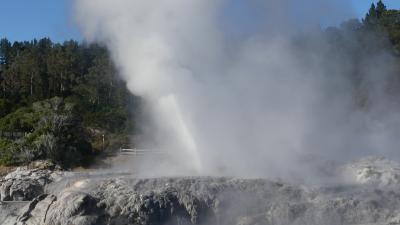
Gysir im "Te Puia" / Geysir at "Te Puia"
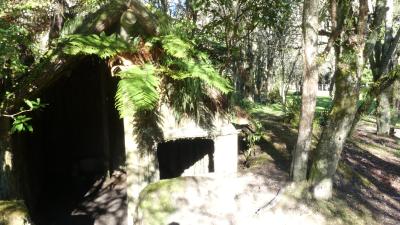
Hütte im begrabenen Dorf / Hut in the buried village
Roadtrip day 16 (Saturday, 09.06.)
In the morning, I visited “Te Puia”. This is a park, which accomodates the bigges geysir in the southern hemisphere. It is very active and shoots the water up to 30m into the air. You can smell the sulphur here as well and it boils and bubbles. There are also schools of the Maori, where you can learn traditional work like weaving and carving but also about their culture. After that I drove to Te Wairoa or better to the buried village. It was buried in 1.5m ashes, dust and mud from a volcanic erruption in the late 19th century. Many people, Maori and europeans, were killed. During the early 20th century, acheologists started to dig it out again. It was very interesting what they found there. Early afternoon I arrived in Whakatane, where I booked a Tour to White Island. A active volcanoe 50kms from the coast of the North Island.
Roadtrip day 17 (Sunday, 10.06.)
This day was disappointing. Yeah, there has to be such a day as well anytime. My tour to White Island was cancelled, due to bad conditions. So I decided to book a skydive in Tauranga, which was approved around midday, But they cancelled that last minute as well, because the clouds were too thick. So I went to the Hot Pools and got a pretty good massage.
Roadtrip day 18 (Monday, 11.06.)
I spend this day on the street again. During the morning I started to north. Better said to Waitangi and the treaty grounds. This is the place where the Treaty of Waitangi was signed by Maori chiefs and britains. As I arrived late afternoon, it was alittle bit too late to visit the museum and the grounds. So I slept nearby at the Waitangi River. During my journey up north, I stopped in Paeroa, where the best Lemonade in the world, L&P, was mixed. Today there is only a 6m tall bottl as a symbol.
Am Morgen besuchte ich zunächst “Te Puia”. Das ist ein Park in dem der größte Geysir der Südhalbkugel beheimatet ist. Er bricht öfters aus und schießt Wasser in bis zu 30m Höhe. Man riecht auch hier den Schwefel und es dampft und brodelt. Dort sind auch Schulen der Maori beheimatet, wo man die traditionellen Arbeiten wie weben und schnitzen und alles über die Kultur lernen kann. Danach fuhr ich weiter nach Te Wairoa bzw. zum begrabenen Dorf. Dies wurde im späten 19. Jahrhundert durch einen Vulkanausbruch in ca. 1,5m Asche, Staub und Schlamm bedeckt. Viele Menschen, Maori und Europäer, ließen ihr leben. Im frühen 20. Jahrhundert fingen Archäologen an die Hütten auszugraben. Es war sehr interessant was sie dort so fanden. Am frühen Nachmittag war ich dann in Whakatane. Dort buchte ich mir eine Tour nach White Island, einen aktiven Hochseevulkan.
Roadtrip Tag 17 (Sonntag, 10.06.)
Auch das gibt es mal. Dieser Tag verlief eher enttäuschend. Meine Tour nach White Island wurde wetterbedingt abgesagt. So entschied ich mich in der nächsten Stadt (Tauranga) einen Skydive zu buchen. Sie hatten glücklicherweise noch einen Termin frei. Mittags wurde mir dann gesagt ich könne springen, was aber in letzter Minute doch gecancelled wurde, weil die Wolken zu dick wurden. So beschloss ich, mich selbst zu verwöhnen. Ich ging in die Therme und lies mich massieren.
Roadtrip Tag 18 (Montag, 11.06.)
Diesen Tag verbrachte ich wieder nur auf der Straße. Ich fuhr nach Norden. Genauer gesagt nach Waitangi. Dort ist das wichtigste Stückchen Land Neuseelands beheimatet. Der Ort an dem der Vertrag von Waitangi zwischen Maori und Briten geschlossen wurde. Da ich aber gegen späten Nachmittag erst ankam war es etwas spät das Museum bzw. das Grundstück zu besuchen. So übernachtete ich direkt am Waitangifluss. Während meiner Fahrt hielt ich noch in Paeroa, wo die beste Limoande der Welt, L&P, erfunden wurde. Heute steht dort nur noch eine ca. 6m hohe Flasche als Symbol.

Gysir im "Te Puia" / Geysir at "Te Puia"

Hütte im begrabenen Dorf / Hut in the buried village
Roadtrip day 16 (Saturday, 09.06.)
In the morning, I visited “Te Puia”. This is a park, which accomodates the bigges geysir in the southern hemisphere. It is very active and shoots the water up to 30m into the air. You can smell the sulphur here as well and it boils and bubbles. There are also schools of the Maori, where you can learn traditional work like weaving and carving but also about their culture. After that I drove to Te Wairoa or better to the buried village. It was buried in 1.5m ashes, dust and mud from a volcanic erruption in the late 19th century. Many people, Maori and europeans, were killed. During the early 20th century, acheologists started to dig it out again. It was very interesting what they found there. Early afternoon I arrived in Whakatane, where I booked a Tour to White Island. A active volcanoe 50kms from the coast of the North Island.
Roadtrip day 17 (Sunday, 10.06.)
This day was disappointing. Yeah, there has to be such a day as well anytime. My tour to White Island was cancelled, due to bad conditions. So I decided to book a skydive in Tauranga, which was approved around midday, But they cancelled that last minute as well, because the clouds were too thick. So I went to the Hot Pools and got a pretty good massage.
Roadtrip day 18 (Monday, 11.06.)
I spend this day on the street again. During the morning I started to north. Better said to Waitangi and the treaty grounds. This is the place where the Treaty of Waitangi was signed by Maori chiefs and britains. As I arrived late afternoon, it was alittle bit too late to visit the museum and the grounds. So I slept nearby at the Waitangi River. During my journey up north, I stopped in Paeroa, where the best Lemonade in the world, L&P, was mixed. Today there is only a 6m tall bottl as a symbol.
phillipt am 12. Juni 18
|
Permalink
|
0 Kommentare
|
kommentieren
Samstag, 9. Juni 2018
Tage 13 bis 15 / Days 13 to 15
Roadtrip Tag 13 (Mittwoch, 06.06.)
Dieser Tag startete damit, dass ich zum Skigebiet des Mt. Ruapehu fuhr. Sir Peter Jackson filmte dort die Aufnahmen für Mordor. Nach drei bis vier Fotos ging es auch direkt weiter (der Schicksalsberg war leider in Wolken verhüllt) auf den “Forgotten World” Highway. Dieser führt durch wunderschöne Landschaften und Schluchten und besteht zum Teil aus Schotterstraße. (Ich war froh als ich Asphalt sah.) Ich passierte den Mt. Egmont/Taranaki, ein ebenfalls aktiver Vulkan, und New Plymouth. An der Küste entlang, ging es dann bis Waitomo, wo ich mir eine Höhlentour buchte und übernachtete.
Roadtrip Tag 14 (Donnerstag, 07.06.)
Donnerstag startete echt super. Ich ging zum Treffpunkt der Höhlentour. Wir waren eine illustre Gruppe aus drei Personen. Wir wurden vom Guide in einen Van verfrachtet und zur “Basis” gebracht. Dort mit Helm, Licht, Gummistiefeln und Neoprenanzug ausgestattet ging es zum Eingang. 7m Leiterklettern und schon war man drin. Es ging auch direkt los mit über Felsen klettern, Informtionen und den ersten Wasserkontakten. Nach einer Weile kamen wir zur ersten “Ringstation”. Wir bekamen große Schwimmringe und ich sprang rückwärts ins kalte Wasser. Nun war ich defintiv und für den ganzen Tag wach. Wir gondelten auf dem Wasser entlang und betrachteten die Glühwürmchen. Auf ca. der Hälfte der Strecke bekamen wir ein heißes Getränk und ich kroch durch den ersten engen Tunnel. Unser Guide schlug vor jemanden von uns führen zu lassen und ich dachte: “Warum nicht?”. Wir gingen auch schon weiter über Felsformationen und durch Wasser. Wir mussten schwimmen und klettern und ich musste mich natürlich wieder durch einen engen Tunnel quetschen. An der zweiten “Ringstation” ging es dann bis fast zum Ende der Höhle. Auf dem Bauch liegend. Wir kletterten hinaus. Die Fürße waren taub, uns war kalt und wir freuten uns auf die heiße Dusche in der “Basis”.
Zurück am Treffpunkt ging es für mich dann zu einem Maori-Pa. Eine kleine Festung oder Fort, wo Vorräte gelagert wurden. Diese Pas liegen vornehmlich auf Hügeln mit steilen Hängen und man erkennt sie an abterrassierten Hängen und Gräben.
Nach diesem “Aufwärmen” (ca. 30 Minuten Wanderung) ging es für mich weiter nach Matamata. Ich habe mir dort eine Filmsettour in Hobbiton gebucht und eine Begegnung mit Maoris in Rotorua.
Roadtrip Tag 15 (Freitag, 08.06.)
Vom Campingplatz aus ging es direkt zum Hobbiton-Filmset. Dort checkte ich ein und später ging es mit dem Bus zum eigentlichen Set. Dies liegt auf einer Farm mit ca. 5 Quadratkilometer Fläche. Der größte Teil ist immernoch Farmland. Das aktuelle Hobbiton, wie es heute steht, ist nach den Hobbitdreharbeiten stehen geblieben um die Touristen anzulocken. Nach den Herr der Ringe-Filmen wurde es teilweise zurückgebaut. Wir bekamen eine ausführliche Tour und erfuhren den ein oder anderen Trick den Sir Peter Jackson und seine Crew benutzten. Wir besuchten auch den “Green Dragon”, der Pub. Dort bekamen wir eine Erfrischung bevor es ins Zelt zum Mittagessen ging. Es war klasse. Es gab allerhand Gemüse und Beilagen und Fleisch. Nach diesem Besuch ging für mich weiter nach Rotorua. Ich buchte mich direkt in den Campingplatz ein und gegen späten Nachmittag ging auch schon die Begegnung mit den Maoris im Tamaki-Dorf los. Wir wurden mit dem Bus dort hin gebracht. Ein Häptling aus der Gruppe wurde auserkoren, der uns ins und im Dorf führt. Er war auch für die Begrüßung zuständig. Die Zeremonie dauerte ein paar Minuten bevor wir rein durften. Drinnen wurden wir herumgeführt, erfuhren einiges über das Leben im Dorf, Freizeit und Kultur. Die Männer der Gruppe (inklusive mir natürlich) durften den Haka lernen und dann auch tanzen. Nach der Führung wurde der Hangi gehoben. Der Hangi ist ein Erdofen, in dem Fleisch, Gemüse und eigentlich alle Mahlzeiten zubereitet wurden. Unten waren heiße Steine, die durch ein Feuer erhitzt wurden, darauf dann die Körbe mit den Zutaten und obendrauf dann Abdeckungen und Erde. Das besondere am Hangi ist, dass alles nur mit Dampf gegart wird. Nach dem Heben bekamen wir eine Show aus traditionellem Tanz und Gesang zu sehen bevor es danach zu unserem Hangimahl ging. Der Tag war auch schon zu Ende und wir wurden zurück gebracht.
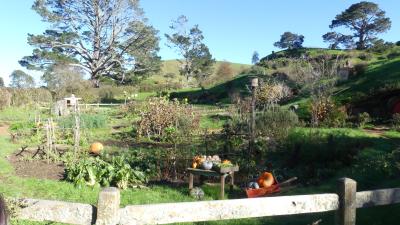
Hobbingen / Hobbiton
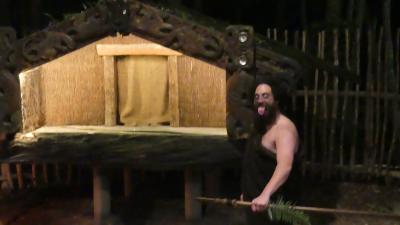
Maoridorf / Maorivillage
Roadtrip day 13 (Wednesday, 06.06.)
This day started, as I drove to the skifield at Mt. Ruapehu. Sir Peter Jackson made the shots for Mordor there. After I took three to four photos (Mt. Doom was covered in clouds, unfortunately), I went on the “Forgotten World highway”. It leads through gorgeous lndscapes and gorges, and is made of gravel, partly. I was happy as I saw asphalt. I passed Mt. Egmont/Mt. Taranaki, also an active volcano, and New Plymouth. Along the coast to Waitomo, where I booked a cave tour and slept for this night.
Roadtrip day 14 (Thursday, 07.06.)
Thursday started very exciting. I went to the meetingpoint for the cavetour. We were a small group of three people. We hopped on a van and drove to the “base”. We were staffed with Helmet, Lights, gumboots and wetsuit and we carried on. 7m down a ladder and we were in. It already started with climbing over rocks, informations and first contacts with water. At the first “Toobingstation” we got some swimrings and I jumped backwards into the cold water. Now I have been definetly awake for the whole day. We cruised on the water and watched the glowworms on the sealing. At about the half of the distance we got a hot drink and I squeezed myself through a tight tunnel. Our guide gave us the opportunity, that one of us guides us and I thought “Why not?”. We went on over rockformations and through water. We had to climb and swim and I had to squeeze myself through another tunnel. At the second “Toobingstation”, we went to almost the end of the cave. We swam on these rings on our bellys. We climed out of the cave, our feet were numb, we were cold and we looked forward to a hot shower in the “base”.
Back at the meeting point, I walked up to a Maori-Pa. This is a small fort, where they stored food or vegetables. These Pas lie on small hills with steep slopes and you recognize them on ditches and trenches on the slopes.
After this “warm up” I drove to Matamata, where I booked a tour at the Hobbiton-filmset and a Maori-encouter in Rotorua.
Roadtrip day 15 (Friday, 08.06.)
I went directly to the Hobbiton-Filmset. After the check-in we were carried with a bus to the actual set. It is located on a farm with about 5km². The major part is still famrland. The set was left after the Hobbit-shootings like it is today to attract tourists. After the LotR-Shootings the removed most of the parts. We got a full tour and aknowledged one or two tricks, which Sir peter Jackson and hi screw used. We also visited the “Green Dragon”, the pub. There, we got a beverage befor we went into the tent for our lunch. We had a lot of everything. Veges, sides and meat. It was great.
After Hobbiton I drove to Rotorua. As I arrived I booked my campsite and I went to the Tamaki-Office at late afternoon. We got there by bus and a chief of the group was chosen. He had to lead us into and through the village. We explored a lot about the kulture, life in a Maorivillage, leisurtime. The men of our group (of course me, too) learnde the Haka and had to dance it. After the guided tour, the Hangi was lifted. The Hangi is an earthoven, where meat, vegetables and all meals were prepared. On the ground are hot stones, which are heated up with fire. On top of that are the baskets witht the food. Everything is coverd. The special thing about the Hangi is, that everything is cooked in the steam. After this lift we saw a show of traditional songs and dance. And at the end we received ozúr Hangimeal. As we finished we are brought back.
Dieser Tag startete damit, dass ich zum Skigebiet des Mt. Ruapehu fuhr. Sir Peter Jackson filmte dort die Aufnahmen für Mordor. Nach drei bis vier Fotos ging es auch direkt weiter (der Schicksalsberg war leider in Wolken verhüllt) auf den “Forgotten World” Highway. Dieser führt durch wunderschöne Landschaften und Schluchten und besteht zum Teil aus Schotterstraße. (Ich war froh als ich Asphalt sah.) Ich passierte den Mt. Egmont/Taranaki, ein ebenfalls aktiver Vulkan, und New Plymouth. An der Küste entlang, ging es dann bis Waitomo, wo ich mir eine Höhlentour buchte und übernachtete.
Roadtrip Tag 14 (Donnerstag, 07.06.)
Donnerstag startete echt super. Ich ging zum Treffpunkt der Höhlentour. Wir waren eine illustre Gruppe aus drei Personen. Wir wurden vom Guide in einen Van verfrachtet und zur “Basis” gebracht. Dort mit Helm, Licht, Gummistiefeln und Neoprenanzug ausgestattet ging es zum Eingang. 7m Leiterklettern und schon war man drin. Es ging auch direkt los mit über Felsen klettern, Informtionen und den ersten Wasserkontakten. Nach einer Weile kamen wir zur ersten “Ringstation”. Wir bekamen große Schwimmringe und ich sprang rückwärts ins kalte Wasser. Nun war ich defintiv und für den ganzen Tag wach. Wir gondelten auf dem Wasser entlang und betrachteten die Glühwürmchen. Auf ca. der Hälfte der Strecke bekamen wir ein heißes Getränk und ich kroch durch den ersten engen Tunnel. Unser Guide schlug vor jemanden von uns führen zu lassen und ich dachte: “Warum nicht?”. Wir gingen auch schon weiter über Felsformationen und durch Wasser. Wir mussten schwimmen und klettern und ich musste mich natürlich wieder durch einen engen Tunnel quetschen. An der zweiten “Ringstation” ging es dann bis fast zum Ende der Höhle. Auf dem Bauch liegend. Wir kletterten hinaus. Die Fürße waren taub, uns war kalt und wir freuten uns auf die heiße Dusche in der “Basis”.
Zurück am Treffpunkt ging es für mich dann zu einem Maori-Pa. Eine kleine Festung oder Fort, wo Vorräte gelagert wurden. Diese Pas liegen vornehmlich auf Hügeln mit steilen Hängen und man erkennt sie an abterrassierten Hängen und Gräben.
Nach diesem “Aufwärmen” (ca. 30 Minuten Wanderung) ging es für mich weiter nach Matamata. Ich habe mir dort eine Filmsettour in Hobbiton gebucht und eine Begegnung mit Maoris in Rotorua.
Roadtrip Tag 15 (Freitag, 08.06.)
Vom Campingplatz aus ging es direkt zum Hobbiton-Filmset. Dort checkte ich ein und später ging es mit dem Bus zum eigentlichen Set. Dies liegt auf einer Farm mit ca. 5 Quadratkilometer Fläche. Der größte Teil ist immernoch Farmland. Das aktuelle Hobbiton, wie es heute steht, ist nach den Hobbitdreharbeiten stehen geblieben um die Touristen anzulocken. Nach den Herr der Ringe-Filmen wurde es teilweise zurückgebaut. Wir bekamen eine ausführliche Tour und erfuhren den ein oder anderen Trick den Sir Peter Jackson und seine Crew benutzten. Wir besuchten auch den “Green Dragon”, der Pub. Dort bekamen wir eine Erfrischung bevor es ins Zelt zum Mittagessen ging. Es war klasse. Es gab allerhand Gemüse und Beilagen und Fleisch. Nach diesem Besuch ging für mich weiter nach Rotorua. Ich buchte mich direkt in den Campingplatz ein und gegen späten Nachmittag ging auch schon die Begegnung mit den Maoris im Tamaki-Dorf los. Wir wurden mit dem Bus dort hin gebracht. Ein Häptling aus der Gruppe wurde auserkoren, der uns ins und im Dorf führt. Er war auch für die Begrüßung zuständig. Die Zeremonie dauerte ein paar Minuten bevor wir rein durften. Drinnen wurden wir herumgeführt, erfuhren einiges über das Leben im Dorf, Freizeit und Kultur. Die Männer der Gruppe (inklusive mir natürlich) durften den Haka lernen und dann auch tanzen. Nach der Führung wurde der Hangi gehoben. Der Hangi ist ein Erdofen, in dem Fleisch, Gemüse und eigentlich alle Mahlzeiten zubereitet wurden. Unten waren heiße Steine, die durch ein Feuer erhitzt wurden, darauf dann die Körbe mit den Zutaten und obendrauf dann Abdeckungen und Erde. Das besondere am Hangi ist, dass alles nur mit Dampf gegart wird. Nach dem Heben bekamen wir eine Show aus traditionellem Tanz und Gesang zu sehen bevor es danach zu unserem Hangimahl ging. Der Tag war auch schon zu Ende und wir wurden zurück gebracht.

Hobbingen / Hobbiton

Maoridorf / Maorivillage
Roadtrip day 13 (Wednesday, 06.06.)
This day started, as I drove to the skifield at Mt. Ruapehu. Sir Peter Jackson made the shots for Mordor there. After I took three to four photos (Mt. Doom was covered in clouds, unfortunately), I went on the “Forgotten World highway”. It leads through gorgeous lndscapes and gorges, and is made of gravel, partly. I was happy as I saw asphalt. I passed Mt. Egmont/Mt. Taranaki, also an active volcano, and New Plymouth. Along the coast to Waitomo, where I booked a cave tour and slept for this night.
Roadtrip day 14 (Thursday, 07.06.)
Thursday started very exciting. I went to the meetingpoint for the cavetour. We were a small group of three people. We hopped on a van and drove to the “base”. We were staffed with Helmet, Lights, gumboots and wetsuit and we carried on. 7m down a ladder and we were in. It already started with climbing over rocks, informations and first contacts with water. At the first “Toobingstation” we got some swimrings and I jumped backwards into the cold water. Now I have been definetly awake for the whole day. We cruised on the water and watched the glowworms on the sealing. At about the half of the distance we got a hot drink and I squeezed myself through a tight tunnel. Our guide gave us the opportunity, that one of us guides us and I thought “Why not?”. We went on over rockformations and through water. We had to climb and swim and I had to squeeze myself through another tunnel. At the second “Toobingstation”, we went to almost the end of the cave. We swam on these rings on our bellys. We climed out of the cave, our feet were numb, we were cold and we looked forward to a hot shower in the “base”.
Back at the meeting point, I walked up to a Maori-Pa. This is a small fort, where they stored food or vegetables. These Pas lie on small hills with steep slopes and you recognize them on ditches and trenches on the slopes.
After this “warm up” I drove to Matamata, where I booked a tour at the Hobbiton-filmset and a Maori-encouter in Rotorua.
Roadtrip day 15 (Friday, 08.06.)
I went directly to the Hobbiton-Filmset. After the check-in we were carried with a bus to the actual set. It is located on a farm with about 5km². The major part is still famrland. The set was left after the Hobbit-shootings like it is today to attract tourists. After the LotR-Shootings the removed most of the parts. We got a full tour and aknowledged one or two tricks, which Sir peter Jackson and hi screw used. We also visited the “Green Dragon”, the pub. There, we got a beverage befor we went into the tent for our lunch. We had a lot of everything. Veges, sides and meat. It was great.
After Hobbiton I drove to Rotorua. As I arrived I booked my campsite and I went to the Tamaki-Office at late afternoon. We got there by bus and a chief of the group was chosen. He had to lead us into and through the village. We explored a lot about the kulture, life in a Maorivillage, leisurtime. The men of our group (of course me, too) learnde the Haka and had to dance it. After the guided tour, the Hangi was lifted. The Hangi is an earthoven, where meat, vegetables and all meals were prepared. On the ground are hot stones, which are heated up with fire. On top of that are the baskets witht the food. Everything is coverd. The special thing about the Hangi is, that everything is cooked in the steam. After this lift we saw a show of traditional songs and dance. And at the end we received ozúr Hangimeal. As we finished we are brought back.
phillipt am 09. Juni 18
|
Permalink
|
0 Kommentare
|
kommentieren
Donnerstag, 7. Juni 2018
...und weiter geht's... / ...and so on...
Roadtrip Tag 10 (Sonntag, 03.06.)
Ich fuhr früh morgens von Palmerston North nach Osten. Genauer gesagt nach Napier. Das Wetter schlug in Regen um und es war ziemlich ungemütlich. In Napier besuchte ich das Nationale Aquarium von Neuseeland. Es hat einen gläsernen Tunnel, von dem man Haie beobachten kann. Danach noch das historische Gefängnis. Das später sogar als Hostel genutzt wurde. Neben dem Gefängnis waren noch die Centennial Gardens. Dies ist ein alter Kalksteinbruch, wo die Insassen arbeit fanden. Später wurde dieser dann als Garten mit Wasserfall, großem Teich, Wegen und wunderschönen Pflanzen angelegt. Im regen lässt sich leider nicht viel unternehmen.
Roadtrip Tag 11 (Montag, 04.06.)
Von Napier aus ging es nach Taupo ins Zentrum der Nordinsel. Das Städtchen liegt am Lake Taupo, der mit 616km² der größte See (flächenmäßig) in Australasien ist. Es regnete immmernoch, doch ich ließ mich nicht abhallten und buchte eine kleine Seekreuzfahrt. Denn am Ufer gibt es eine riesige Steinschnitzerei, die einen Maori-Häuptlig darstellt. Entgegen aller Gedanken ist die Schnitzerei modern. Sie wure 1976 angefertigt. Für diese Nacht, und zur Freude meines Rückens, buchte ich mich in ein Hostel ein.
Roadtrip Tag 12 (Dienstag, 05.06.)
Gegen späten Vormittag fuhr ich los um in Orakei Korake die geothermischen Quellen zu besuchen. Dies ist eine große Terrasse, die zum größten Teil aus Silikaten besteht und von diesen gebildet wurde. Die Luft stinkt nach faulen Eiern, was auf den Schwefelgehalt des Wassers und des Bodens zurückzuführen ist. Auch einige Schlammpools waren zu sehen. Orakei Korake beherbergt auch eine riesige Höhle. Der Rundgang dauert ca. 1,5 Stunden und die Farben, die die Algen und Mineralien hevorrufen, sind gigantisch. Auch den einen oder anderen, kleinen Geysir gibt es zu bestaunen. Danach fuhr ich zu “Craters of the Moon”. Ein weitere geothermisches Gebiet nördlich von Taupo. Ich sah riesige Krater, die durch “Verstopfungen” der Öffnungen und den dadurch stiegenden Druck und die Explosion entstanden. Auch hier roch es gewaltig nach dem Schwefel und es dampfte, brodelte und zischte aus den Öffnungen im Boden.
Es war früher Nachmittag und ich startete zu meinem nächsten Ziel. Ich nahm den Highway entlang am See und sah auch schon die ersten Vulkane am Horizont. Genauer gesagt den Mt. Nguruhoe oder auch Schicksalsberg (aus Herr der Ringe). Der sogar noch aktiv ist, aber momentan auf der niedrigsten Stufe steht. Ich hatte Glück, denn als ich den Berg passierte, brach die Wolkendecke un dich hatte einen herrlichen Blick auf den Berg. Die Straße führte auch durch die Rangipo-Wüste. Keine Wüste im eigentlichen Sinne. Die Bodenbeschaffenheit hält nur keine Feuchtigkeit, was es höheren Pflanzen unmöglich macht zu wachsen. Ein Teil der Wüste wird als Truppenübungsaresl genutzt. Diese Nacht verbrachte ich am Fuße des Mt. Ruapehu, ein anderer aktiver Vulkan.
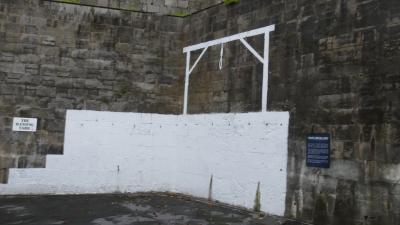
Hänge-Platz im Gefängnis / Hanging yard at the prison
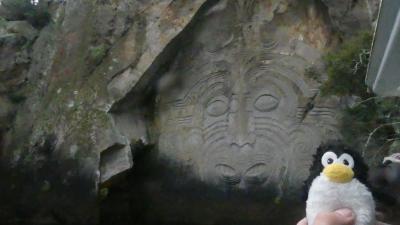
Pingu an der Schnitzerei / Pingu at the carving
Roadtrip day 10 (Sunday, 03.06.)
Early morning, I drove from Palmerston North to Napier. The weather changed to rain. In Napier I visited the National Aquarium of New Zealand. It has a glasstunnel, from which you can see sharks. After that the historic prison, which was used as a hostel later. Next to the prison are the centenniel gardens. Which was a limestone quarry, where the inmates of the prison found work. Later it was created as a garden with a waterfall, big pond, paths and beautiful plants. Due to the rain, I didn't do that much.
Roadtrip day 11 (Monday, 04.06.)
From Napier, I went to Taupo, The centre of the North Island. The township is on the Lake Taupo, which is with 616km² the biggest lake (surface) in Australasia. It still rained. But I booked a small cruise on lake anyway. There is a big carving in the rocks on the shore, which displays a Maorichief. Against all thoughts, this carving is modern. It was made in 1976. For this night, and for my back, I booked a hostel.
Roadtrip day 12 (Ttuesday, 05.06.)
Late morning, I headed off to Orakei Korake, where you can find geothermal sources. Orakei Korake is a big terrace from silicates. The air smells like rotten eggs, which is caused of the sulphur in the water and in the ground. Orakei Korake has also some mudpools and a big cave. The walk takes around 1.5 hours and the colours, which are caused by the algae and minerals are awesome. After that I went to the “Craters of the Moon”. Another geothermal area north of Taupo. I saw big craters, which resulted of a stuck “vent”, the rising pressure and the resultesd explosion. The air smelled like rotten eggs as well and it bubbled, steamed and hissed out of the gaps in the ground.
Early afternoon and I started for my next destination. I took the highway along the lake and I saw the first volcanoes at the horizon. Say Mt. Nguruhoe or Mt. Doom from Lord of the Rings, which is active but on the lowest scale. I have been lucky, because as I passed the mountain, the clouds disappeared and the sun came out, so that I can take some pictures. The highway leads through the Rangipo-Desert. Not a desert in the proper sense, but the soil doesn't hold moisture, which makes it impossible for higher plants to grow. This desert ist partly used as a military training area. I spent his night under the Mt. Ruapehu, another active volcano.
Ich fuhr früh morgens von Palmerston North nach Osten. Genauer gesagt nach Napier. Das Wetter schlug in Regen um und es war ziemlich ungemütlich. In Napier besuchte ich das Nationale Aquarium von Neuseeland. Es hat einen gläsernen Tunnel, von dem man Haie beobachten kann. Danach noch das historische Gefängnis. Das später sogar als Hostel genutzt wurde. Neben dem Gefängnis waren noch die Centennial Gardens. Dies ist ein alter Kalksteinbruch, wo die Insassen arbeit fanden. Später wurde dieser dann als Garten mit Wasserfall, großem Teich, Wegen und wunderschönen Pflanzen angelegt. Im regen lässt sich leider nicht viel unternehmen.
Roadtrip Tag 11 (Montag, 04.06.)
Von Napier aus ging es nach Taupo ins Zentrum der Nordinsel. Das Städtchen liegt am Lake Taupo, der mit 616km² der größte See (flächenmäßig) in Australasien ist. Es regnete immmernoch, doch ich ließ mich nicht abhallten und buchte eine kleine Seekreuzfahrt. Denn am Ufer gibt es eine riesige Steinschnitzerei, die einen Maori-Häuptlig darstellt. Entgegen aller Gedanken ist die Schnitzerei modern. Sie wure 1976 angefertigt. Für diese Nacht, und zur Freude meines Rückens, buchte ich mich in ein Hostel ein.
Roadtrip Tag 12 (Dienstag, 05.06.)
Gegen späten Vormittag fuhr ich los um in Orakei Korake die geothermischen Quellen zu besuchen. Dies ist eine große Terrasse, die zum größten Teil aus Silikaten besteht und von diesen gebildet wurde. Die Luft stinkt nach faulen Eiern, was auf den Schwefelgehalt des Wassers und des Bodens zurückzuführen ist. Auch einige Schlammpools waren zu sehen. Orakei Korake beherbergt auch eine riesige Höhle. Der Rundgang dauert ca. 1,5 Stunden und die Farben, die die Algen und Mineralien hevorrufen, sind gigantisch. Auch den einen oder anderen, kleinen Geysir gibt es zu bestaunen. Danach fuhr ich zu “Craters of the Moon”. Ein weitere geothermisches Gebiet nördlich von Taupo. Ich sah riesige Krater, die durch “Verstopfungen” der Öffnungen und den dadurch stiegenden Druck und die Explosion entstanden. Auch hier roch es gewaltig nach dem Schwefel und es dampfte, brodelte und zischte aus den Öffnungen im Boden.
Es war früher Nachmittag und ich startete zu meinem nächsten Ziel. Ich nahm den Highway entlang am See und sah auch schon die ersten Vulkane am Horizont. Genauer gesagt den Mt. Nguruhoe oder auch Schicksalsberg (aus Herr der Ringe). Der sogar noch aktiv ist, aber momentan auf der niedrigsten Stufe steht. Ich hatte Glück, denn als ich den Berg passierte, brach die Wolkendecke un dich hatte einen herrlichen Blick auf den Berg. Die Straße führte auch durch die Rangipo-Wüste. Keine Wüste im eigentlichen Sinne. Die Bodenbeschaffenheit hält nur keine Feuchtigkeit, was es höheren Pflanzen unmöglich macht zu wachsen. Ein Teil der Wüste wird als Truppenübungsaresl genutzt. Diese Nacht verbrachte ich am Fuße des Mt. Ruapehu, ein anderer aktiver Vulkan.

Hänge-Platz im Gefängnis / Hanging yard at the prison

Pingu an der Schnitzerei / Pingu at the carving
Roadtrip day 10 (Sunday, 03.06.)
Early morning, I drove from Palmerston North to Napier. The weather changed to rain. In Napier I visited the National Aquarium of New Zealand. It has a glasstunnel, from which you can see sharks. After that the historic prison, which was used as a hostel later. Next to the prison are the centenniel gardens. Which was a limestone quarry, where the inmates of the prison found work. Later it was created as a garden with a waterfall, big pond, paths and beautiful plants. Due to the rain, I didn't do that much.
Roadtrip day 11 (Monday, 04.06.)
From Napier, I went to Taupo, The centre of the North Island. The township is on the Lake Taupo, which is with 616km² the biggest lake (surface) in Australasia. It still rained. But I booked a small cruise on lake anyway. There is a big carving in the rocks on the shore, which displays a Maorichief. Against all thoughts, this carving is modern. It was made in 1976. For this night, and for my back, I booked a hostel.
Roadtrip day 12 (Ttuesday, 05.06.)
Late morning, I headed off to Orakei Korake, where you can find geothermal sources. Orakei Korake is a big terrace from silicates. The air smells like rotten eggs, which is caused of the sulphur in the water and in the ground. Orakei Korake has also some mudpools and a big cave. The walk takes around 1.5 hours and the colours, which are caused by the algae and minerals are awesome. After that I went to the “Craters of the Moon”. Another geothermal area north of Taupo. I saw big craters, which resulted of a stuck “vent”, the rising pressure and the resultesd explosion. The air smelled like rotten eggs as well and it bubbled, steamed and hissed out of the gaps in the ground.
Early afternoon and I started for my next destination. I took the highway along the lake and I saw the first volcanoes at the horizon. Say Mt. Nguruhoe or Mt. Doom from Lord of the Rings, which is active but on the lowest scale. I have been lucky, because as I passed the mountain, the clouds disappeared and the sun came out, so that I can take some pictures. The highway leads through the Rangipo-Desert. Not a desert in the proper sense, but the soil doesn't hold moisture, which makes it impossible for higher plants to grow. This desert ist partly used as a military training area. I spent his night under the Mt. Ruapehu, another active volcano.
phillipt am 07. Juni 18
|
Permalink
|
0 Kommentare
|
kommentieren
Dienstag, 5. Juni 2018
Teil 3 / Part 3
Roadtrip Tag 7 (Donnerstag, 31.05.)
Aufstehen um 6 Uhr war angesagt. Heute steht die Überfahrt auf die Nordinsel an. 7 Uhr war Check-In zur Fähre. Diese legte mit ca. 45 Minuten Verspätung ab. Macht nichts. Ich stärkte mich mit einem Frühstück und einem Kaffee und dann ging es auch hinaus aufs Deck um die vorbeiziehende Laandschaft des Queen Charlotte Sunds zu sehen. Auch Delfine spielten in den Wellem um das Schiff. Auf der Cook Straße (zwischen Nord- und Südinsel) ging es recht rauh zu. Nach ca. 3 Stunden überfahrt kamen wir in Wllington, Neuseelands Hauptstadt, an. Ich verfuhr mich 5 Mal bis ich endlich einen Parkplatz gefunden habe. Ich bin die Großstadt nicht mehr gewöhnt. Dann besuchte ich Old St.Paul's. Eine wunderschöne alte Kirche, die komplett aus Holz gebaut wurde. Ich stromerte so durch die Gegend und besuchte die deutsche Botschaft und den Bienenstock. Das ist das Parlamentsgebäude. Es heißt so, weil es so aussieht. Ich machte die Tour mit, die umsonst ist und durch allerhand Räumlichkeiten und sogar den Plänarsaal führt. Mein Tag war auch schon zu Ende und ich verirrte mich auf den Campingplatz.
Roadtrip Tag 8 (Freitag, 01.06.)
Ich hab brutal verschlafen. Aber gegen Mittag war ich endlich in der Stadt. Ich besuchte das Te Papa Tongarewa. Das Nationalmuseum Neuseelands. Das ist wie die staatlichen Museen in UK umsonst. Ich erfuhr allerhand über die große Schlacht von Gallilpolli, in der Australische und Neuseeländische Truppen Seite an Seite gegen die türkischen Truppen im ersten Weltkrieg kämpften. Auch sonst wurde im Prinzip die ganze geschichtliche Entwicklung Neuseelands unter verschiedenen Gesichtspunkten wie Maori, Natur, europäische Siedler ausgeleuchtet. Ich verbrachte dort etwa 4 bis 5 Stunden. Danach war Sightseeing angesagt. Im Regen. Ich wanderte zum ältesten Haus Wellingtons und durch die Cuba Street, die Einkaufs- und Kneipenmeile. Ich besuchte auch kurz den Nachtmarkt, der, aufgrund des Wetters, ziemlich klein ausfiel.
Roadtrip Tag 9 (Samstag, 02.06.)
Heute fuhr ich mit dem Cablecar auf einen Berg in Wellington. Die Fahrt dauerte keine 5 Minuten und die Bahnen fahren alle 10 Minuten an den Stationen ab. Die strecke führt durch einige Tunnels mit Lichtershow. Oben angekommen schaute ich mir das zugehörige Museum und Wellington von oben an. Da ich aber auch weiter wollte, fiel dieser Besuch kurz aus. Ich fuhr weiter nach Palmerston North. Dort angekommen besuchte ich das Rugby-Museum und das Te Manawa-Museum, in dem regionale Besonderheiten und Natur ausgestellt sind.
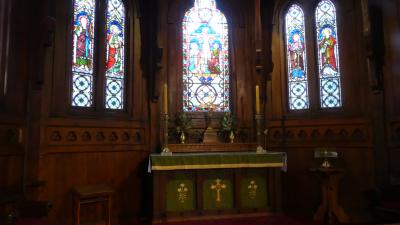
Old St. Paul's
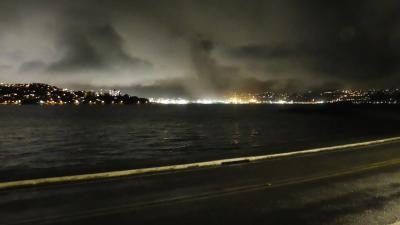
Wellington des Nachts / Wellington at night
Roadtrip day 7 (31.05.)
Wake up at 6am. Today was the transfer to the North Island. Check in was at 7am. The ferry departed with 45 minutes delay. Doesn't matter. I had a good breakfast and a coffee. I went outside to see the landscape of the Queen Charlotte Sound and saw some dolphins playing in the waves around the ship. On the Cook Strait (between North and South Island) was the sea a little rough. After approx. 3 hours, we arrived in Wellington The capital of New Zealand. I got lost several times until I found a parking space. I am not used to big cities anymore. I visited Old st. Pauls. A very beautiful old church, completley made of timber. I strolled around, went to the german embassy and to the Beehive. This is the parliament, which is so called, because it looks like that. I took part on tour there. The tour is for free and you can see almost everything, especially the Chamber. My day was over and I got lost to the campground.
Roadtrip day 8 (Friday, 01.06.)
I overslept. But around midday, I arrived in Wellington City. I went to Te Papa Tongarewa; the Museum of New Zealand. This is, as the national museums in UK for free. I explored a lot about the battle of Gallipolli, where Australian and NZ Troups, fought side by side against the Turks in the first Worldwar. In the end, the whole development of New Zealand is exhibited, under different views like Maori, Nature, european seddlers. It took me 4 to 5 hours. After that was sightseeing. In the rain. I walked to the oldest house in Wellington and through the Cuba Street. The shopping mile, as well as I visited the Night Market, which was small, due to the weather.
Roadtrip day 9 (Saturday, 02.06.)
Today I took the cablecar in Wellington. The time wasn't even five minutes and the cars depart every ten minutes from the stations. The route has several tunnels, which are providing a lightshow. As I arrived on top, I visited the Cablecar-Museum and I watched Wellington from above. As I wanted to continue with my trip, the visit there was short as well. I continued to Palmerston North, where I visited the Rugby Musuem and the Te Manawa, where regional culture and nature I exhibited.
Aufstehen um 6 Uhr war angesagt. Heute steht die Überfahrt auf die Nordinsel an. 7 Uhr war Check-In zur Fähre. Diese legte mit ca. 45 Minuten Verspätung ab. Macht nichts. Ich stärkte mich mit einem Frühstück und einem Kaffee und dann ging es auch hinaus aufs Deck um die vorbeiziehende Laandschaft des Queen Charlotte Sunds zu sehen. Auch Delfine spielten in den Wellem um das Schiff. Auf der Cook Straße (zwischen Nord- und Südinsel) ging es recht rauh zu. Nach ca. 3 Stunden überfahrt kamen wir in Wllington, Neuseelands Hauptstadt, an. Ich verfuhr mich 5 Mal bis ich endlich einen Parkplatz gefunden habe. Ich bin die Großstadt nicht mehr gewöhnt. Dann besuchte ich Old St.Paul's. Eine wunderschöne alte Kirche, die komplett aus Holz gebaut wurde. Ich stromerte so durch die Gegend und besuchte die deutsche Botschaft und den Bienenstock. Das ist das Parlamentsgebäude. Es heißt so, weil es so aussieht. Ich machte die Tour mit, die umsonst ist und durch allerhand Räumlichkeiten und sogar den Plänarsaal führt. Mein Tag war auch schon zu Ende und ich verirrte mich auf den Campingplatz.
Roadtrip Tag 8 (Freitag, 01.06.)
Ich hab brutal verschlafen. Aber gegen Mittag war ich endlich in der Stadt. Ich besuchte das Te Papa Tongarewa. Das Nationalmuseum Neuseelands. Das ist wie die staatlichen Museen in UK umsonst. Ich erfuhr allerhand über die große Schlacht von Gallilpolli, in der Australische und Neuseeländische Truppen Seite an Seite gegen die türkischen Truppen im ersten Weltkrieg kämpften. Auch sonst wurde im Prinzip die ganze geschichtliche Entwicklung Neuseelands unter verschiedenen Gesichtspunkten wie Maori, Natur, europäische Siedler ausgeleuchtet. Ich verbrachte dort etwa 4 bis 5 Stunden. Danach war Sightseeing angesagt. Im Regen. Ich wanderte zum ältesten Haus Wellingtons und durch die Cuba Street, die Einkaufs- und Kneipenmeile. Ich besuchte auch kurz den Nachtmarkt, der, aufgrund des Wetters, ziemlich klein ausfiel.
Roadtrip Tag 9 (Samstag, 02.06.)
Heute fuhr ich mit dem Cablecar auf einen Berg in Wellington. Die Fahrt dauerte keine 5 Minuten und die Bahnen fahren alle 10 Minuten an den Stationen ab. Die strecke führt durch einige Tunnels mit Lichtershow. Oben angekommen schaute ich mir das zugehörige Museum und Wellington von oben an. Da ich aber auch weiter wollte, fiel dieser Besuch kurz aus. Ich fuhr weiter nach Palmerston North. Dort angekommen besuchte ich das Rugby-Museum und das Te Manawa-Museum, in dem regionale Besonderheiten und Natur ausgestellt sind.

Old St. Paul's

Wellington des Nachts / Wellington at night
Roadtrip day 7 (31.05.)
Wake up at 6am. Today was the transfer to the North Island. Check in was at 7am. The ferry departed with 45 minutes delay. Doesn't matter. I had a good breakfast and a coffee. I went outside to see the landscape of the Queen Charlotte Sound and saw some dolphins playing in the waves around the ship. On the Cook Strait (between North and South Island) was the sea a little rough. After approx. 3 hours, we arrived in Wellington The capital of New Zealand. I got lost several times until I found a parking space. I am not used to big cities anymore. I visited Old st. Pauls. A very beautiful old church, completley made of timber. I strolled around, went to the german embassy and to the Beehive. This is the parliament, which is so called, because it looks like that. I took part on tour there. The tour is for free and you can see almost everything, especially the Chamber. My day was over and I got lost to the campground.
Roadtrip day 8 (Friday, 01.06.)
I overslept. But around midday, I arrived in Wellington City. I went to Te Papa Tongarewa; the Museum of New Zealand. This is, as the national museums in UK for free. I explored a lot about the battle of Gallipolli, where Australian and NZ Troups, fought side by side against the Turks in the first Worldwar. In the end, the whole development of New Zealand is exhibited, under different views like Maori, Nature, european seddlers. It took me 4 to 5 hours. After that was sightseeing. In the rain. I walked to the oldest house in Wellington and through the Cuba Street. The shopping mile, as well as I visited the Night Market, which was small, due to the weather.
Roadtrip day 9 (Saturday, 02.06.)
Today I took the cablecar in Wellington. The time wasn't even five minutes and the cars depart every ten minutes from the stations. The route has several tunnels, which are providing a lightshow. As I arrived on top, I visited the Cablecar-Museum and I watched Wellington from above. As I wanted to continue with my trip, the visit there was short as well. I continued to Palmerston North, where I visited the Rugby Musuem and the Te Manawa, where regional culture and nature I exhibited.
phillipt am 05. Juni 18
|
Permalink
|
0 Kommentare
|
kommentieren
Freitag, 1. Juni 2018
Abenteuer die Zweite/Adventure the second
Roadtrip Tag 4 (Montag, 28.05.)
Noch in Westport schaute ich mir das Coaltown-Museum an. Dort wird gezeigt, wie an der Westküste Steinkohle abgebaut wurde und unter welchen Umständen. Riesige Maschinen und Wägen sind dort zu sehen. Es wurde sogar ein Minenschacht nachgebaut. Da das Museum recht klein ist, war ich ziemlich schnell durch und ich fuhr nun Richtung Osten. Quer durch die südlichen Alpen nach Kaikoura. Nach ca. 5 Stunden kam ich an und buchte mir direkt eine Tour zum Wale beobachten. Die Nacht verbrachte ich auf einem kleinen Campingplatz direkt am Strand etwas südlich von Kaikoura.
Roadtrip Tag 5 (Dienstag, 29.05.)
Leider wurde die Waltour am Morgen aufgrund der rauen See abgesagt und so buchte ich auf den Nachmittag um. Um mir die Wartezeit zu vertreiben, fuhr ich auf die Kaikoura-Halbinsel hinaus. Ich wanderte herum und sah eine große Seehundkolonie. Leider wurde die Nachmittagstour auch abgesagt und so beschloss ich weiter zu fahren. Auf dem Weg nach Picton stoppte ich an einem Luftfahrtmuseum in Blenheim. Ich schaute mir die Ausstellung der Maschinen des ersten Weltkriegs an. Die Ausstellung wurde von Sir Peter Jackson mit Freunden der Artefakte aus Blenheim iniziiert. Als ich in Picton ankam buchte ich direkt einen Platz auf der Fähre für Donnerstag.
Roadtrip Tag 6 (Mittwoch, 30.05.)
Dieser Tag war leider auch nicht so erfolgreich. Ich verschlief den Start der Tour um mit Delfinen zu schwimmen und so buchte ich einen Platz auf der Wildnistour am Nachmittag. Ich schaute mir Picton an und das Aquarium. Da ich der einzige Besucher zu dieser Zeit war bekam ich sozusagen eine Privattour. Ich streichelte einen Tuatara (lebendes Fossil/Echse) und einen Seestern. Am frühen Nachmittag wurde dann auch leider die Wildnistour abgesagt, weil nicht genügend Leute zusammen kamen. Also schaute ich mir das 9.-älteste Schiff der Welt an. Die Edwin Fox. Sie wurde zum Gefangenentransport von UK nach Australien benutzt, schiffte Güter und Kriegsmaterial für die Kriege der Engländer. Später dann Handelsschiff und Immigrantentransport. Am Schluss Lagerschiff für die Kühlhallen im Hafen (Die Hallen wurden mit Kohlebetriebenen Maschinen gekühlt). Später wurde sie ihrem Schicksal überlassen, geplündert und Ende des 20. Jahrhunderts wurde sie in ihr finales Trockendock verlegt, wo man sie heute besichtigen kann. Sogar ein Teil des Innenlebens wurde nach gebaut und man fühlt quasi das Leben auf dem Schiff. Auch das äußere des Schiffs lässt sich hautnah begutachten und man sieht deutlich die Spuren der See und des Wetters.
...Fortsetzung folgt!
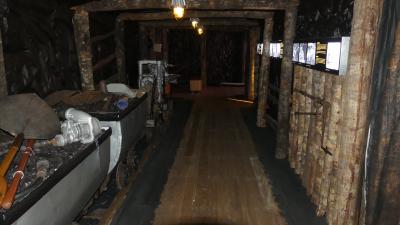
Minenschacht / Mine
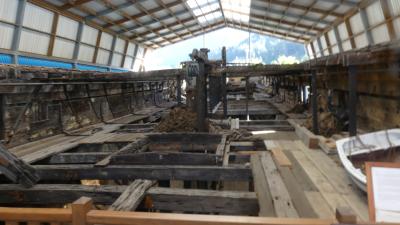
"Edwin Fox"
Roadtrip Day 4 (Monday, 28.05.)
Still in Westport, I visited the Coaltown-Museum. One can see there, how they gathered coal in this area and under which circumstances. There are huge wagons and machines displayed. The even display a old mine. The Museum isn't very big so I finished it very quick. After that I headed to the East. I crossed the country through the Southern Alps to Kaikoura. After five hours of driving I arrived and booked a Whalewatch-Tour. I slept at a small campground next to the beach a little bit south of Kaikoura.
Roadtrip Day 5 (Tuesday, 29.05.)
Unfortunately, the Whalewatch was cancelled due to rough sea in the morning. So I rescheduled for the afternoon. To use the time, I drove to the Kaikoura-Peninsula. I wandered around and saw a big sealcolony. The tour in the afternoon was cancelled, too. So I decided to drive to Picton. In Blenheim, I visited the Aviation Heritage Museum. I saw the exhibition of the planes of Worldwar I. This exhibition was iniciated from Sir Peter Jackson, with friends of the heritage from Blenheim. As I arrived in Picton, I booked the ferry for Thursday.
Roadtrip Day 6 (Wednesday, 30.05.)
This day wasn't that successful, too. I slept too long and I couldn't get a space for the Doplhin-Swim-Tour. So I booked a place for ther Wilderness-Tour in the afternoon. I strolled through Picton and visited the aquarium. I was the only visitor so I got a private tour. I patted a Tuatara (living Fossil/Lizard) and a starfish. In the early afternoon, the wilderness-tour was cancelled, too, because there weren't enough people. Because of that I had a look on the nineth-oldest ship in the world. The Edwin Fox. She was used for transporting convicts from UK to Australia, brought goods and ammo and stuff to the troups of the english during wartimes. Later, she was used for transporting goods and commercial stuff. She transported immigrants as well. Later she was used for storage next to the refridgerated storagehouses (at this time coealfired machines cooled the Houses down). After that she was given to her fate, plundered and “dumped”. At the end of the 20th century she was rescued and put in her final dry-dock, where you can see her today. Parts of the inner decks were rebuilt and you can feel the life on the ship. The outter side of the “Edwin Fox” is visible, too, and one can see the traces of the sea and weather.
...to be continued!
Noch in Westport schaute ich mir das Coaltown-Museum an. Dort wird gezeigt, wie an der Westküste Steinkohle abgebaut wurde und unter welchen Umständen. Riesige Maschinen und Wägen sind dort zu sehen. Es wurde sogar ein Minenschacht nachgebaut. Da das Museum recht klein ist, war ich ziemlich schnell durch und ich fuhr nun Richtung Osten. Quer durch die südlichen Alpen nach Kaikoura. Nach ca. 5 Stunden kam ich an und buchte mir direkt eine Tour zum Wale beobachten. Die Nacht verbrachte ich auf einem kleinen Campingplatz direkt am Strand etwas südlich von Kaikoura.
Roadtrip Tag 5 (Dienstag, 29.05.)
Leider wurde die Waltour am Morgen aufgrund der rauen See abgesagt und so buchte ich auf den Nachmittag um. Um mir die Wartezeit zu vertreiben, fuhr ich auf die Kaikoura-Halbinsel hinaus. Ich wanderte herum und sah eine große Seehundkolonie. Leider wurde die Nachmittagstour auch abgesagt und so beschloss ich weiter zu fahren. Auf dem Weg nach Picton stoppte ich an einem Luftfahrtmuseum in Blenheim. Ich schaute mir die Ausstellung der Maschinen des ersten Weltkriegs an. Die Ausstellung wurde von Sir Peter Jackson mit Freunden der Artefakte aus Blenheim iniziiert. Als ich in Picton ankam buchte ich direkt einen Platz auf der Fähre für Donnerstag.
Roadtrip Tag 6 (Mittwoch, 30.05.)
Dieser Tag war leider auch nicht so erfolgreich. Ich verschlief den Start der Tour um mit Delfinen zu schwimmen und so buchte ich einen Platz auf der Wildnistour am Nachmittag. Ich schaute mir Picton an und das Aquarium. Da ich der einzige Besucher zu dieser Zeit war bekam ich sozusagen eine Privattour. Ich streichelte einen Tuatara (lebendes Fossil/Echse) und einen Seestern. Am frühen Nachmittag wurde dann auch leider die Wildnistour abgesagt, weil nicht genügend Leute zusammen kamen. Also schaute ich mir das 9.-älteste Schiff der Welt an. Die Edwin Fox. Sie wurde zum Gefangenentransport von UK nach Australien benutzt, schiffte Güter und Kriegsmaterial für die Kriege der Engländer. Später dann Handelsschiff und Immigrantentransport. Am Schluss Lagerschiff für die Kühlhallen im Hafen (Die Hallen wurden mit Kohlebetriebenen Maschinen gekühlt). Später wurde sie ihrem Schicksal überlassen, geplündert und Ende des 20. Jahrhunderts wurde sie in ihr finales Trockendock verlegt, wo man sie heute besichtigen kann. Sogar ein Teil des Innenlebens wurde nach gebaut und man fühlt quasi das Leben auf dem Schiff. Auch das äußere des Schiffs lässt sich hautnah begutachten und man sieht deutlich die Spuren der See und des Wetters.
...Fortsetzung folgt!

Minenschacht / Mine

"Edwin Fox"
Roadtrip Day 4 (Monday, 28.05.)
Still in Westport, I visited the Coaltown-Museum. One can see there, how they gathered coal in this area and under which circumstances. There are huge wagons and machines displayed. The even display a old mine. The Museum isn't very big so I finished it very quick. After that I headed to the East. I crossed the country through the Southern Alps to Kaikoura. After five hours of driving I arrived and booked a Whalewatch-Tour. I slept at a small campground next to the beach a little bit south of Kaikoura.
Roadtrip Day 5 (Tuesday, 29.05.)
Unfortunately, the Whalewatch was cancelled due to rough sea in the morning. So I rescheduled for the afternoon. To use the time, I drove to the Kaikoura-Peninsula. I wandered around and saw a big sealcolony. The tour in the afternoon was cancelled, too. So I decided to drive to Picton. In Blenheim, I visited the Aviation Heritage Museum. I saw the exhibition of the planes of Worldwar I. This exhibition was iniciated from Sir Peter Jackson, with friends of the heritage from Blenheim. As I arrived in Picton, I booked the ferry for Thursday.
Roadtrip Day 6 (Wednesday, 30.05.)
This day wasn't that successful, too. I slept too long and I couldn't get a space for the Doplhin-Swim-Tour. So I booked a place for ther Wilderness-Tour in the afternoon. I strolled through Picton and visited the aquarium. I was the only visitor so I got a private tour. I patted a Tuatara (living Fossil/Lizard) and a starfish. In the early afternoon, the wilderness-tour was cancelled, too, because there weren't enough people. Because of that I had a look on the nineth-oldest ship in the world. The Edwin Fox. She was used for transporting convicts from UK to Australia, brought goods and ammo and stuff to the troups of the english during wartimes. Later, she was used for transporting goods and commercial stuff. She transported immigrants as well. Later she was used for storage next to the refridgerated storagehouses (at this time coealfired machines cooled the Houses down). After that she was given to her fate, plundered and “dumped”. At the end of the 20th century she was rescued and put in her final dry-dock, where you can see her today. Parts of the inner decks were rebuilt and you can feel the life on the ship. The outter side of the “Edwin Fox” is visible, too, and one can see the traces of the sea and weather.
...to be continued!
phillipt am 01. Juni 18
|
Permalink
|
0 Kommentare
|
kommentieren
Letztes Abenteuer / Last Adventure
Meine Arbeitzeit in Neuseeland ist zu Ende. Der Winter ist da und ich bin weg. Aus Queenstown zumindest. Ich startete am 25. Mai meinen finalen Roadtrip durch Neuseeland. Ich fuhr die Westküste ab, kreuzte das Land und fuhr von Kaikoura nach Norden. In Picton nahm ich die Fähre nach Wellington und von dort aus fahre ich die Nordinsel im Zick-Zack ab. Abflug ist in Auckland.
Was ich bisher so erlebt habe auf meiner großen Reise beschreibe ich euch hier:
Roadtrip Tag 1 (Freitag, 25.05.)
Dieser Tag bestand eigentlich nur aus fahren, fahren, fahren. Ich fuhr von Queenstown nach Franz Josef. Der Haast-Pass war zwar geöffnet aber die Straßen mit einer Schicht aus Schneematsch bedeckt, so dass die Fahrt etwas länger dauerte als geplant. Auch die alpine Landschaft faszinierte mich, weshalb ich etwas langsamer fuhr. Ich stoppte noch bei den Blue pools. Eine kleine Schlucht mit karibisch blauem Wasser. Als ich in der Ortschaft Franz Josef ankam, buchte ich mir direkt für den nächsten Tag einen Helikopterflug mit Schneelandung auf den Gletscher. Danach direkt auf den Campingplatz und dann war auch Schluss.
Roadtrip Tag 2 (Samstag, 26.05.)
Samstag war dafür umso spannender. Morgens ging es direkt mit dem Helikopter in die Berge. Wir überflogen den Franz Josef Gletscher (12km lang, 4m Strecke pro Tag). Nach ein paar Minuten und einigen Fotos zwischen den Gipfeln im Schnee flogen wir auch schon wieder zurück.
Ich fuhr direkt weiter Richtung Norden. Immer an der Westküste entlang. Auf dem Weg nach Hokitika besuchte ich noch einen Baumwipfelpfad. In Hokitika selbst verbrachte ich zunächst einige Zeit am Strand. Nachmittags suchte ich mir eine Werkstatt in der man Greenstone bearbeiten kann und ich buchte mich direkt ein. Dreieinhalb Stunden später hatte ich eine fertige Kette mit dem Symbol des Manaia. Diese Nacht verbrachte ich auf einem Campingplatz etwas außerhalb.
Roadtrip Tag 3 (Sonntag, 27.05.)
Sonntagmorgen schaute ich mir Hokitika an. Gegen Mittag fuhr ich weiter nach Punakaiki. Dort gibt es eine interessante Felsformation. Die Pancake-Rocks (Pfannkuchen-Felsen). Sie heißen so, weil sie aussehen als wären Pfannkuchen gestapelt worden. Durch Erosion wurden weiche Gesteine ausgepült und formten die Rillen und so gennannte Blaslöcher, durch die das Wasser hochspritzt. Ähnlich wie wenn ein Wal bläst. Als ich weiter nach Norden fuhr, kam ich nach Greymouth. Dort ist eine Goldgräberstadt wieder aufgebaut. Ich habe diese auch besucht und so das Leben in den 1860er Jahren hautnah erlebt. Danach war noch etwas Zeit und ich beschloss noch nach Westport zu fahren. Natürlich hatte ich immer meine Kamera griffbereit und ich hielt von Zeit zu Zeit um Bilder der urwaldähnlichen Landschaft an der Westküste zu machen.
...Fortsetzung folgt!
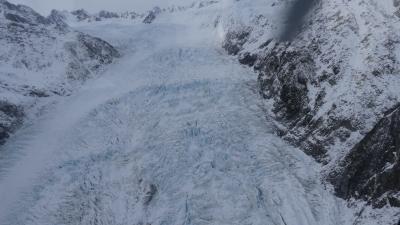
Franz-Josef
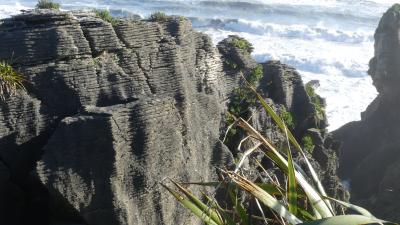
Pfannkuchen-Felsen/Pancake Rocks
My working time in NZ is over. Winter is here, and I am gone. At least from Queenstown. I started my final roadtrip on the 25th of May. I drove along the westcoast, crossed the counrty and headed north from Kaikoura. In Picton I took the ferry to Wellington and from there I'll do the North-Island in a Zig-zag.
I will write here what I have done then:
Roadtrip Day 1 (Friday, 25.05)
This day was only driving, driving, driving. I drove from Queenstown to Franz Josef. The Haast-Pass was open but there was slushy snow on the street, which took me longer. As well as the alpine landscape, which was fascinating. I stopped at the Blue Pools. It is a small gorge with carribiean blue water. As I arrived in Franz-Josef-Township I booked a helicopter flight to the top of the glacier with snowlanding. After that directly to the campground and that was it for the day.
Roadtrip Day 2 (Saturday, 26.05.)
Saturday was more exciting. I flew with a helicopter into the mountains. I saw the Franz-Josef-Glacier (12km long, 4m distance per day). After a few minutes and some photos in the snow, we flew back. I departed immediately to the North always along the coast. On my way to Hokitika, I visited a tree-top-walk. As I arrived in Hokitika, I spent some time on the beach and looked for a workshop, where I can carve some Ponamu/Greenstone. After 3.5 hours I had a finished necklace with the symbol of the Manaia. I slept on a campground a little bit out of town.
Roadtrip Day 3 (Sunday, 27.05.)
On Sunday morning, I went for Sightseeing to Hokitika. Around noon, I headed further North to Punakaiki. There are interesting rockformations. The “Pancake-Rocks”, they are named like that becaue they look like stacked up pancakes. Water and weather eroded smooth stone and formed the gaps and so called blowholes, through where water comes aup. Similar to a whale. As I drove further North, I reached Greymouth, where an old shantytown is rebuilt. I visited it and saw how they lived in the 1860s. As I had time I headed off, for Westport. And of course I stopped from time to time to make photos of the beautiful landscape and nature of the Westcoast.
...to be continued!
Was ich bisher so erlebt habe auf meiner großen Reise beschreibe ich euch hier:
Roadtrip Tag 1 (Freitag, 25.05.)
Dieser Tag bestand eigentlich nur aus fahren, fahren, fahren. Ich fuhr von Queenstown nach Franz Josef. Der Haast-Pass war zwar geöffnet aber die Straßen mit einer Schicht aus Schneematsch bedeckt, so dass die Fahrt etwas länger dauerte als geplant. Auch die alpine Landschaft faszinierte mich, weshalb ich etwas langsamer fuhr. Ich stoppte noch bei den Blue pools. Eine kleine Schlucht mit karibisch blauem Wasser. Als ich in der Ortschaft Franz Josef ankam, buchte ich mir direkt für den nächsten Tag einen Helikopterflug mit Schneelandung auf den Gletscher. Danach direkt auf den Campingplatz und dann war auch Schluss.
Roadtrip Tag 2 (Samstag, 26.05.)
Samstag war dafür umso spannender. Morgens ging es direkt mit dem Helikopter in die Berge. Wir überflogen den Franz Josef Gletscher (12km lang, 4m Strecke pro Tag). Nach ein paar Minuten und einigen Fotos zwischen den Gipfeln im Schnee flogen wir auch schon wieder zurück.
Ich fuhr direkt weiter Richtung Norden. Immer an der Westküste entlang. Auf dem Weg nach Hokitika besuchte ich noch einen Baumwipfelpfad. In Hokitika selbst verbrachte ich zunächst einige Zeit am Strand. Nachmittags suchte ich mir eine Werkstatt in der man Greenstone bearbeiten kann und ich buchte mich direkt ein. Dreieinhalb Stunden später hatte ich eine fertige Kette mit dem Symbol des Manaia. Diese Nacht verbrachte ich auf einem Campingplatz etwas außerhalb.
Roadtrip Tag 3 (Sonntag, 27.05.)
Sonntagmorgen schaute ich mir Hokitika an. Gegen Mittag fuhr ich weiter nach Punakaiki. Dort gibt es eine interessante Felsformation. Die Pancake-Rocks (Pfannkuchen-Felsen). Sie heißen so, weil sie aussehen als wären Pfannkuchen gestapelt worden. Durch Erosion wurden weiche Gesteine ausgepült und formten die Rillen und so gennannte Blaslöcher, durch die das Wasser hochspritzt. Ähnlich wie wenn ein Wal bläst. Als ich weiter nach Norden fuhr, kam ich nach Greymouth. Dort ist eine Goldgräberstadt wieder aufgebaut. Ich habe diese auch besucht und so das Leben in den 1860er Jahren hautnah erlebt. Danach war noch etwas Zeit und ich beschloss noch nach Westport zu fahren. Natürlich hatte ich immer meine Kamera griffbereit und ich hielt von Zeit zu Zeit um Bilder der urwaldähnlichen Landschaft an der Westküste zu machen.
...Fortsetzung folgt!

Franz-Josef

Pfannkuchen-Felsen/Pancake Rocks
My working time in NZ is over. Winter is here, and I am gone. At least from Queenstown. I started my final roadtrip on the 25th of May. I drove along the westcoast, crossed the counrty and headed north from Kaikoura. In Picton I took the ferry to Wellington and from there I'll do the North-Island in a Zig-zag.
I will write here what I have done then:
Roadtrip Day 1 (Friday, 25.05)
This day was only driving, driving, driving. I drove from Queenstown to Franz Josef. The Haast-Pass was open but there was slushy snow on the street, which took me longer. As well as the alpine landscape, which was fascinating. I stopped at the Blue Pools. It is a small gorge with carribiean blue water. As I arrived in Franz-Josef-Township I booked a helicopter flight to the top of the glacier with snowlanding. After that directly to the campground and that was it for the day.
Roadtrip Day 2 (Saturday, 26.05.)
Saturday was more exciting. I flew with a helicopter into the mountains. I saw the Franz-Josef-Glacier (12km long, 4m distance per day). After a few minutes and some photos in the snow, we flew back. I departed immediately to the North always along the coast. On my way to Hokitika, I visited a tree-top-walk. As I arrived in Hokitika, I spent some time on the beach and looked for a workshop, where I can carve some Ponamu/Greenstone. After 3.5 hours I had a finished necklace with the symbol of the Manaia. I slept on a campground a little bit out of town.
Roadtrip Day 3 (Sunday, 27.05.)
On Sunday morning, I went for Sightseeing to Hokitika. Around noon, I headed further North to Punakaiki. There are interesting rockformations. The “Pancake-Rocks”, they are named like that becaue they look like stacked up pancakes. Water and weather eroded smooth stone and formed the gaps and so called blowholes, through where water comes aup. Similar to a whale. As I drove further North, I reached Greymouth, where an old shantytown is rebuilt. I visited it and saw how they lived in the 1860s. As I had time I headed off, for Westport. And of course I stopped from time to time to make photos of the beautiful landscape and nature of the Westcoast.
...to be continued!
phillipt am 01. Juni 18
|
Permalink
|
0 Kommentare
|
kommentieren
Dienstag, 22. Mai 2018
Zum Abschluss / At the end
Naja wie soll ich sagen? Eigentlich bin ich ein Feigling wenn es um extreme Dinge geht. So verweigerte ich immer einen Bungeejump. Bis zu jenem Tag, als mich ein Mitbewohner überredete mit ihm und zwei anderen Mitbewohnern zu springen.
Um der Erinnerung willen. Und er hatte recht.
Samstag war Sprungtag. Zunächst zum Büro um einzuchecken. Dort mussten wir dann warten, bis uns der Bus abholte, der uns zum Nevis-Bungeejump bringt. Dieser ist mit 134m der höchste in Neuseeland. Die Nervosität stieg an und die Musik im Bus trug nicht gerade zur Beruhigung bei (Highway to hell, etc.). Nach ca. 40 min Fahrt kamen wir an der “Basis” an. Dort wurden wir direkt mit Sicherungsgurten ausgestattet. Nach einer Wartezeit ging es mit einer Gondel zu der Absprungstelle, die eine große Kabine ist, die an Stahlseilen über der Schlucht befestigt ist. Es war ziemlich windig und alles hat geschuakelt. Auch hier mussten wir dann wieder warten, währenddessen gewöhnte ich mich an die Höhe. Möchte man meinen. Als ich dann endlich dran war ging mir ganz schön die Düse. Man ist zwar doppelt und dreifach gesichert... aber es geht ca. 200m in den Abgrund!! (Also von Absprungspunkt bis zum Fluss, der die Schlucht formte.)
Ich weigerste mich zunächst zu springen und wollte schon aufgeben. Doch meine Mitmenschen feuerten mich an und der Mitarbeiter redete mir gut zu. Und da dachte ich mir (Entschuldigt die Wortwahl) Scheiß drauf! Ich tus! Und ich ließ mich fallen.
Ich merkte gar nicht, dass ich falle. Beim dritten Mal abfedern musste man einen Bolzen zwischen den Beinen lösen, der einen kopfüber hielt. Als der Bolzen lose war, drehte man sich in eine sitzende Position und man wurde in die Seilwinde eingeklinkt und wieder hinaufgezogen.
Noch die Fotos gekauft und dann ging es auch schon relativ zügig wieder zurück nach Queenstown.
...Fortsetzung folgt!
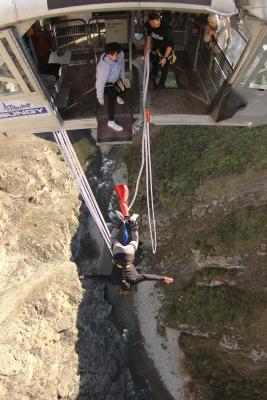
How can I say? I am a chicken, when it comes to extreme things. So I refused to do a bungeejump. Until that day a housemate coaxed me to do a jump. As well with two other mates.
For memories sake. And he was right.
Saturday was jumpingday. At first to the office for checking in. We had to wait there until the bus, which brings us to the Nevis-Bungeejump, picked us up. This is with 134m the highest in New Zealand. I got more and more nervous and the music in the bus dind't calm us down (Highway to hell etc.). After 40 min of driving we reached the “base”. We had to put on the harnesses almost immediately. After a time of waiting we had to reach the cabin with a gondola. The cabin is hung up on steelropes above the gorge. It was pretty windy and everything shaked. We had to wait here as well. I got used to the height, meanwhile. I thought so. As I was supposed to jump, I felt like a chicken again. Of course, you are secured twice and three times... but there is a hieght of around 200m into the gorge!! (From the cabin to the river, which formed the canyon.) At first, I refused to jump and wanted to give up. But my mates cheered me up and the guy talked very calmed me down. And then I tought (sorry for the language) Fuck it! I do it! And I fell.
I didn't realize that I fall. At the third rebound, I had to loosen a bolt between my legs, which held me heads first. I flipped into a sitting position and the winch was letched and I was pulled up again.
I bought the pictures and after that, we drove back to Queenstown.
...to be continued!
Um der Erinnerung willen. Und er hatte recht.
Samstag war Sprungtag. Zunächst zum Büro um einzuchecken. Dort mussten wir dann warten, bis uns der Bus abholte, der uns zum Nevis-Bungeejump bringt. Dieser ist mit 134m der höchste in Neuseeland. Die Nervosität stieg an und die Musik im Bus trug nicht gerade zur Beruhigung bei (Highway to hell, etc.). Nach ca. 40 min Fahrt kamen wir an der “Basis” an. Dort wurden wir direkt mit Sicherungsgurten ausgestattet. Nach einer Wartezeit ging es mit einer Gondel zu der Absprungstelle, die eine große Kabine ist, die an Stahlseilen über der Schlucht befestigt ist. Es war ziemlich windig und alles hat geschuakelt. Auch hier mussten wir dann wieder warten, währenddessen gewöhnte ich mich an die Höhe. Möchte man meinen. Als ich dann endlich dran war ging mir ganz schön die Düse. Man ist zwar doppelt und dreifach gesichert... aber es geht ca. 200m in den Abgrund!! (Also von Absprungspunkt bis zum Fluss, der die Schlucht formte.)
Ich weigerste mich zunächst zu springen und wollte schon aufgeben. Doch meine Mitmenschen feuerten mich an und der Mitarbeiter redete mir gut zu. Und da dachte ich mir (Entschuldigt die Wortwahl) Scheiß drauf! Ich tus! Und ich ließ mich fallen.
Ich merkte gar nicht, dass ich falle. Beim dritten Mal abfedern musste man einen Bolzen zwischen den Beinen lösen, der einen kopfüber hielt. Als der Bolzen lose war, drehte man sich in eine sitzende Position und man wurde in die Seilwinde eingeklinkt und wieder hinaufgezogen.
Noch die Fotos gekauft und dann ging es auch schon relativ zügig wieder zurück nach Queenstown.
...Fortsetzung folgt!

How can I say? I am a chicken, when it comes to extreme things. So I refused to do a bungeejump. Until that day a housemate coaxed me to do a jump. As well with two other mates.
For memories sake. And he was right.
Saturday was jumpingday. At first to the office for checking in. We had to wait there until the bus, which brings us to the Nevis-Bungeejump, picked us up. This is with 134m the highest in New Zealand. I got more and more nervous and the music in the bus dind't calm us down (Highway to hell etc.). After 40 min of driving we reached the “base”. We had to put on the harnesses almost immediately. After a time of waiting we had to reach the cabin with a gondola. The cabin is hung up on steelropes above the gorge. It was pretty windy and everything shaked. We had to wait here as well. I got used to the height, meanwhile. I thought so. As I was supposed to jump, I felt like a chicken again. Of course, you are secured twice and three times... but there is a hieght of around 200m into the gorge!! (From the cabin to the river, which formed the canyon.) At first, I refused to jump and wanted to give up. But my mates cheered me up and the guy talked very calmed me down. And then I tought (sorry for the language) Fuck it! I do it! And I fell.
I didn't realize that I fall. At the third rebound, I had to loosen a bolt between my legs, which held me heads first. I flipped into a sitting position and the winch was letched and I was pulled up again.
I bought the pictures and after that, we drove back to Queenstown.
...to be continued!
phillipt am 22. Mai 18
|
Permalink
|
0 Kommentare
|
kommentieren
Sonntag, 29. April 2018
Herbst in NZ / Autumn in NZ
Der Herbst hat hier in Neuseeland Einzug gehalten. Es ist kalt, nass, regnersich.
Aber es gibt auch schöne Seiten. Vor allem die Farben der Bäume in Arrowtown.
Dieses leuchtende gelb über orange bis hin zu rot. Einmalig! Solche Farben habe ich selten in Deutschland gesehen.
Arrowtown feiert jedes Jahr ein Herbstfestival, das ca. Eine Woche stattfindet. Meine Mitbewohner und ich beschlossen hinzugehen. Und es war eine gute Entscheidung. Kameras, gute Laune und los ging es. Nach einem Snack schlenderten wir durch das von Menschen gefüllte Arrowtown. Zum Fluss hinunter und wieder zurück um danach auf eine große Grünfläche am Fuße der umliegenden Hügel zu relaxen und die Sonne zu genießen. Und natürlich um Fotos zu schießen.
Diese will ich euch natürlich nicht vorenthalten. Deswegen hier ein paar Fotos.
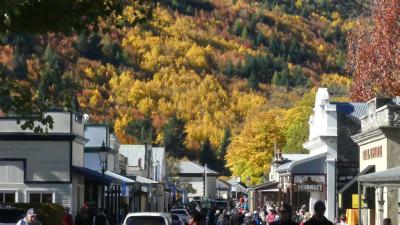

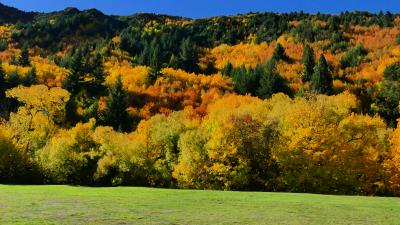
Autumn finally arrived in New Zealand. It is cold, wet, rainy.
But there are beautiful sides, too. Especially the colour of the trees in Arrowtown.
This bright yellow with orange and red. Unique! I haven't seen such colours in Germany that much.
Arrowotwn celebrates an Autumnfestival every year. It takes place for one week. My housemates and I decided to go. And it was a good decision. Cameras, good mood and we started. After a snack we strolled around the crowded Arrowtown. Down to the river, back through the towncenter and afterwards to a green beneath the surrounding hills, where we relaxed and enjoyed the sun. And of course took heaps of pictures.
I don't want to hide them from you, so you can see them above.
Aber es gibt auch schöne Seiten. Vor allem die Farben der Bäume in Arrowtown.
Dieses leuchtende gelb über orange bis hin zu rot. Einmalig! Solche Farben habe ich selten in Deutschland gesehen.
Arrowtown feiert jedes Jahr ein Herbstfestival, das ca. Eine Woche stattfindet. Meine Mitbewohner und ich beschlossen hinzugehen. Und es war eine gute Entscheidung. Kameras, gute Laune und los ging es. Nach einem Snack schlenderten wir durch das von Menschen gefüllte Arrowtown. Zum Fluss hinunter und wieder zurück um danach auf eine große Grünfläche am Fuße der umliegenden Hügel zu relaxen und die Sonne zu genießen. Und natürlich um Fotos zu schießen.
Diese will ich euch natürlich nicht vorenthalten. Deswegen hier ein paar Fotos.



Autumn finally arrived in New Zealand. It is cold, wet, rainy.
But there are beautiful sides, too. Especially the colour of the trees in Arrowtown.
This bright yellow with orange and red. Unique! I haven't seen such colours in Germany that much.
Arrowotwn celebrates an Autumnfestival every year. It takes place for one week. My housemates and I decided to go. And it was a good decision. Cameras, good mood and we started. After a snack we strolled around the crowded Arrowtown. Down to the river, back through the towncenter and afterwards to a green beneath the surrounding hills, where we relaxed and enjoyed the sun. And of course took heaps of pictures.
I don't want to hide them from you, so you can see them above.
phillipt am 29. April 18
|
Permalink
|
0 Kommentare
|
kommentieren
Sonntag, 8. April 2018
Te Anau / Glühwürmchen / Glowworms
Ostermontag, 2. April 2018
Ich habe frei, das Wetter ist gut. Also wurde ein Trip geplant. Programmpunkt war diesmal ein Besuch der Glühwurm-Höhlen in Te Anau ca. 2 Stunden Busfahrt von Queenstown entfernt.
Um zu den Höhlen zu gelangen fährt man ca. eine halbe Stunde mit dem Boot über den See.
Der Lake Te Anau hat eine Oberfläche von 344 km² und eine maximale Tiefe von 270m. Er ist der zweitgrößte See in Neuseeland und der größte auf der Südinsel/Te Waipounamu. Er fasst mehr als 70 Milliarden Liter Frischwasser und ist somit das größte Süßwasservorkommen in Australasien.
Auch hier gibt es eine Maorilegende. Der Häuptling Te Horo entdeckte eine heilige Quelle und erzählte seiner Frau davon. Während einer langen Reise Te Horos wurde sie ihm untreu und zeigte die Quelle ihrem Liebhaber. In dem Moment, als sein Gesicht sich im Wasser spiegelte, begann diese zu sprudeln, flutete das Tal, versenkte das Dorf und formte den See.
Drei Fjorde sind an der westlichen Seite des Sees zu finden, die die Täler formten. Lake Te Anau hat mehrere Zuflüsse und einen Abfluss, der den Manapouri-See formt und von dort aus bis in den Ozean fließt. Der größte Teil des Sees liegt im Fjordlandnationalpark (größter Nationalpark in NZ) und einige Multi-Day-tracks starten an der Westküste des Sees.
Nun zur Höhle. Das Höhlensystem wird Aurora-Höhlen-System genannt und ist ca. 6,7 km lang. Sie sind ca. 12.000 Jahre jung, die Steine drumherum ca. 35 Millionen Jahre. Das Wasser kommt von den Berggipfeln in einen See und das, was “überschwappt” fließt durch Spalten in den Boden und formt die Höhle.
Und somit komme ich zum eigentlichen Grund des Besuchs: die Glühwürmchen. Diese leben in 4 Stadien. Zunächst das Ei. Die Weibchen legen ca 130 Eier aus denen 3 Wochen später die Jungtiere schlüpfen. Meist das ganze Jahr über. Direkt nach dem Schlüpfen fängt die Larve an ihr Nest zu bauen und Futter zu fangen. Sobald die Larven 3 bis 4 cm lang sind (9 Monate), verpuppen sie sich. Die Metarmorphose von Larve zu Fliege dauert 12 bis 13 Tage. Die adulte Fliege hat keinen Mund. D.h. Die Männchen befruchten in ihren 5 Tagen Lebenszeit so viele Weibchen wie möglich. Wohingegen die Weibchen direkt nach der Eiablage. Beide sterben aufgrund mangelnder Ernährung und der großen Anstrengung.
Die Nester bestehen aus 2 bis 15 cm langen “Fischerschnüren”. Bis zu 70 an der Zahl. Ein Glühwürmchen benötigt ca. 40 Minuten um 10 cm Schnur zu produzieren. Diese “Fischerschnüre” bestehen aus dicken Schleimtropfen (die ein bisschen aussehen wie Perlen wenn sie das Licht reflektieren).
Die Beute wird durch das leuchtende Hinterteil der sich im Larvenstadium befindlichen Würmchen angelockt. An den Schleimtropfen bleibt die Beute hängen und sie wird direkt durch Chemikalien gelähmt. Danach wird die Beute direkt getötet und gefressen. Der Wurm “schlürft” die Lebenssäfte des Opfers aus. Je heller ein Wurmpo leuchtet desto hungriger ist die Larve. Das blaue Leuchten wird durch chemikalien im Körper produziert. Fast gleich wie die Biolumineszenz in den tiefsten Tiefen der Ozeane. Die Beute sind meistens Sandflys die die Höhle nicht verlassen, weil deren Eier direkt im Wasser unter den Glühwürmchen reifen.
Leider durften wir keine Bilder im inneren der Höhle machen. Deshalb hier eine Beschreibung:
Der Eingang ist ca. Einen Meter hoch. Also gebückt und reingekrochen. Alles ist mit befestigten Stahlwegen/Rampen ausgestattet. Man ist also sicher, denn unter einem rauscht das Wasser gen See. Der Stahlweg ist beleuchtet und man muss immer auf seinen Kopf aufpassen oder sich beugen bzw. Schräg laufen um sich nicht zu verletzen. Im inneren ist es durch rauschende Wasserfälle sehr laut. Je weiter man in die Höhle kommt, desto dunkler wird es und man sieht die ersten blauen Leuchtpunkte an der Decke. Dort wo die Würmchen eigentlich hängen, formte sich ein kleiner See und man wird in Boote verfrachtet. Nur zum ein- und aussteigen wird Licht gemacht. Das Boot wird komplett im Dunkeln an einer Kette entlang gezogen.
Wir sahen Gruppen von blauen, leuchtenden Punkten an der Decke. Man spürte, dass etwas vor einem ist. Man durfte sich weder vorn überbeugen, noch die Hände aus dem Boot strecken wegen den Felsen. Das Boot wurde so nah an die Würmchen herangesteuert, dass man ca. 20 cm davon entfernt war. Man glaubt es kaum, aber die Summe der leuchtenden Hinterteile und die reflektionen im Wasser war so stark, dass man teilweise etwas erkennen konnte.
Nach zwei bis drei Runden im Dunkeln ging es auch wieder zur Anlegestelle. Und von dort aus relativ zügig wieder raus und auf das Boot, dass uns wieder zurück nach Te Anau brachte.
...Fortsetzung folgt!
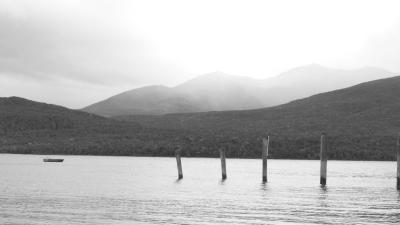
Lake Te Anau
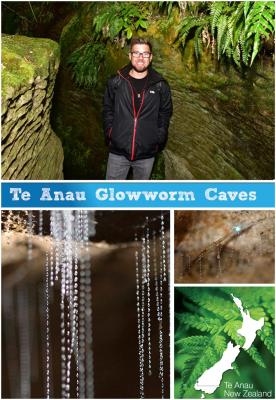
Ich am Eingang (oben) / me at the entrance (top)
Fischerschnüre (uL) / fishing lines (down left)
Glühwurm (mR) / Glowworm (middle, right)
Eastermonday, April the 2nd
I have a day off and decided to make a trip. This time the program said: Glowworm Caves in Te Anau, which is about two hours from Queenstown. To reach the caves you have to take the boat for about 30 minutes.
Lake Te Anau has a surfcae of 344 km² and a maximum depth of 270 m. It is the second biggest lake in New Zealand and the biggest on the South Island/Te Waipounamu. The lake has more than 70 billion liters of water and froms the biggest source of freshwater in australasia. Of course there is a legend from the Maori. The chief Te Horo discovered a magic spring. He told his wife to tell nobody about it. As Te Horo went on a long journey, his wife showed the spirng to her lover. As soon as the lovers face was mirrored in the waters of the spring it started to flow more and more – flooded the valley, drowned the valley and formed the lake.
Three fiords are found on the western side of the lake, which formed the valleys. Lake Te Anau has three inflows and one outflow which forms the Lake Manapouri and goes from there to the ocean. The major part of Lake Te Anau is in the Fiordland Nationalpark (biggest in NZ) and several multi-day-tracks are starting at the coastline of the lake.
Now the caves. They are called the Aurora-cave-System and it is about 6.7 km long. The caves are 12.000 years old, which is young. The stones around it are 35 million years old. The water comes from the peaks around into a small lake. The “overflow” flows into gaps in the soil and forms the caves.
And now the real reason for my visit of the caves: the glowworms. They live in four phases. First the egg. Females lay around 130 eggs of which the worms are hatching three weeks later. Mostly during the whole year. Directly after that, the larva starts to build its own nest and wait for food. As soon as the larvas are 3 to 4 cm long (9 months) it turns into a pupa. The metarmorphosis from larva to adult fly takes around 12 to 13 days. The adult fly doesn't have a mouth. So the male trys to mate as much femals in its 5 days of life. The female lays its eggs and dies immediately. Both die because of the lack of food and stress.
The nests are made of up to 70, two to 15 cm long “Fishinglines”. One worm needs up to 40 minutes for producing 10 cm line. They are made of drops of mucus, which are looking like pearls if they reflect the light.
The prey is attracted by the glowing butt of the worms, which are in the state of a larva. In the fishinglines of mucus, the victim stucks and get paralyzed by chemicals. The prey is killed directly and eaten by the worm. These worms are sucking the juices out of their prey. The brighter a wormlarva glows, the hungrier they are. The blue light is produced by chemicals, similar to the bioluminescence in the depths of the oceans. Most of the victims are Sandflys, which don't leave the cave because their eggs are laying in the water beneath the glowworms.
Unfortunately it wasn't allowed to take pictures inside of the cave. Now you get a description of that. The entrance is ca. one meter high. So we had to duck down and get in. Everything is made with steelpaths/ramps. So it was save to walk. The water was rushing to the lake beneath us. The path was lighted and you have to be careful with your head. Sometimes bend over the handrails. Inside it is very loud because of the waterfalls.
The more, we got into the cave, the darker it got and you see the first blue spots on the ceiling. There, where the worms are, is a small lake and you have to enter a boat. Only for get into and out of the boat is light. The boat is pulled by the guide on a chain in complete darkness.
We saw groups of blue, glowing dots on the ceiling. I felt that something is in front of me. So it is not allowed to bend yourself over the edge of the boat or put out your hands because of the rocks. The boat was steered so close to the worms, that it was a distance about 20 cm. You can't believe it but the sum of the glowing butts and their reflections on the water were so strong that I could recognize some things around me.
After two to three rounds in the dark, the boat went back to the place where we entered. After that the tour was over and we went out of the cave and on the boat, which brang us back to Te Anau.
...to be continued!
Ich habe frei, das Wetter ist gut. Also wurde ein Trip geplant. Programmpunkt war diesmal ein Besuch der Glühwurm-Höhlen in Te Anau ca. 2 Stunden Busfahrt von Queenstown entfernt.
Um zu den Höhlen zu gelangen fährt man ca. eine halbe Stunde mit dem Boot über den See.
Der Lake Te Anau hat eine Oberfläche von 344 km² und eine maximale Tiefe von 270m. Er ist der zweitgrößte See in Neuseeland und der größte auf der Südinsel/Te Waipounamu. Er fasst mehr als 70 Milliarden Liter Frischwasser und ist somit das größte Süßwasservorkommen in Australasien.
Auch hier gibt es eine Maorilegende. Der Häuptling Te Horo entdeckte eine heilige Quelle und erzählte seiner Frau davon. Während einer langen Reise Te Horos wurde sie ihm untreu und zeigte die Quelle ihrem Liebhaber. In dem Moment, als sein Gesicht sich im Wasser spiegelte, begann diese zu sprudeln, flutete das Tal, versenkte das Dorf und formte den See.
Drei Fjorde sind an der westlichen Seite des Sees zu finden, die die Täler formten. Lake Te Anau hat mehrere Zuflüsse und einen Abfluss, der den Manapouri-See formt und von dort aus bis in den Ozean fließt. Der größte Teil des Sees liegt im Fjordlandnationalpark (größter Nationalpark in NZ) und einige Multi-Day-tracks starten an der Westküste des Sees.
Nun zur Höhle. Das Höhlensystem wird Aurora-Höhlen-System genannt und ist ca. 6,7 km lang. Sie sind ca. 12.000 Jahre jung, die Steine drumherum ca. 35 Millionen Jahre. Das Wasser kommt von den Berggipfeln in einen See und das, was “überschwappt” fließt durch Spalten in den Boden und formt die Höhle.
Und somit komme ich zum eigentlichen Grund des Besuchs: die Glühwürmchen. Diese leben in 4 Stadien. Zunächst das Ei. Die Weibchen legen ca 130 Eier aus denen 3 Wochen später die Jungtiere schlüpfen. Meist das ganze Jahr über. Direkt nach dem Schlüpfen fängt die Larve an ihr Nest zu bauen und Futter zu fangen. Sobald die Larven 3 bis 4 cm lang sind (9 Monate), verpuppen sie sich. Die Metarmorphose von Larve zu Fliege dauert 12 bis 13 Tage. Die adulte Fliege hat keinen Mund. D.h. Die Männchen befruchten in ihren 5 Tagen Lebenszeit so viele Weibchen wie möglich. Wohingegen die Weibchen direkt nach der Eiablage. Beide sterben aufgrund mangelnder Ernährung und der großen Anstrengung.
Die Nester bestehen aus 2 bis 15 cm langen “Fischerschnüren”. Bis zu 70 an der Zahl. Ein Glühwürmchen benötigt ca. 40 Minuten um 10 cm Schnur zu produzieren. Diese “Fischerschnüre” bestehen aus dicken Schleimtropfen (die ein bisschen aussehen wie Perlen wenn sie das Licht reflektieren).
Die Beute wird durch das leuchtende Hinterteil der sich im Larvenstadium befindlichen Würmchen angelockt. An den Schleimtropfen bleibt die Beute hängen und sie wird direkt durch Chemikalien gelähmt. Danach wird die Beute direkt getötet und gefressen. Der Wurm “schlürft” die Lebenssäfte des Opfers aus. Je heller ein Wurmpo leuchtet desto hungriger ist die Larve. Das blaue Leuchten wird durch chemikalien im Körper produziert. Fast gleich wie die Biolumineszenz in den tiefsten Tiefen der Ozeane. Die Beute sind meistens Sandflys die die Höhle nicht verlassen, weil deren Eier direkt im Wasser unter den Glühwürmchen reifen.
Leider durften wir keine Bilder im inneren der Höhle machen. Deshalb hier eine Beschreibung:
Der Eingang ist ca. Einen Meter hoch. Also gebückt und reingekrochen. Alles ist mit befestigten Stahlwegen/Rampen ausgestattet. Man ist also sicher, denn unter einem rauscht das Wasser gen See. Der Stahlweg ist beleuchtet und man muss immer auf seinen Kopf aufpassen oder sich beugen bzw. Schräg laufen um sich nicht zu verletzen. Im inneren ist es durch rauschende Wasserfälle sehr laut. Je weiter man in die Höhle kommt, desto dunkler wird es und man sieht die ersten blauen Leuchtpunkte an der Decke. Dort wo die Würmchen eigentlich hängen, formte sich ein kleiner See und man wird in Boote verfrachtet. Nur zum ein- und aussteigen wird Licht gemacht. Das Boot wird komplett im Dunkeln an einer Kette entlang gezogen.
Wir sahen Gruppen von blauen, leuchtenden Punkten an der Decke. Man spürte, dass etwas vor einem ist. Man durfte sich weder vorn überbeugen, noch die Hände aus dem Boot strecken wegen den Felsen. Das Boot wurde so nah an die Würmchen herangesteuert, dass man ca. 20 cm davon entfernt war. Man glaubt es kaum, aber die Summe der leuchtenden Hinterteile und die reflektionen im Wasser war so stark, dass man teilweise etwas erkennen konnte.
Nach zwei bis drei Runden im Dunkeln ging es auch wieder zur Anlegestelle. Und von dort aus relativ zügig wieder raus und auf das Boot, dass uns wieder zurück nach Te Anau brachte.
...Fortsetzung folgt!

Lake Te Anau

Ich am Eingang (oben) / me at the entrance (top)
Fischerschnüre (uL) / fishing lines (down left)
Glühwurm (mR) / Glowworm (middle, right)
Eastermonday, April the 2nd
I have a day off and decided to make a trip. This time the program said: Glowworm Caves in Te Anau, which is about two hours from Queenstown. To reach the caves you have to take the boat for about 30 minutes.
Lake Te Anau has a surfcae of 344 km² and a maximum depth of 270 m. It is the second biggest lake in New Zealand and the biggest on the South Island/Te Waipounamu. The lake has more than 70 billion liters of water and froms the biggest source of freshwater in australasia. Of course there is a legend from the Maori. The chief Te Horo discovered a magic spring. He told his wife to tell nobody about it. As Te Horo went on a long journey, his wife showed the spirng to her lover. As soon as the lovers face was mirrored in the waters of the spring it started to flow more and more – flooded the valley, drowned the valley and formed the lake.
Three fiords are found on the western side of the lake, which formed the valleys. Lake Te Anau has three inflows and one outflow which forms the Lake Manapouri and goes from there to the ocean. The major part of Lake Te Anau is in the Fiordland Nationalpark (biggest in NZ) and several multi-day-tracks are starting at the coastline of the lake.
Now the caves. They are called the Aurora-cave-System and it is about 6.7 km long. The caves are 12.000 years old, which is young. The stones around it are 35 million years old. The water comes from the peaks around into a small lake. The “overflow” flows into gaps in the soil and forms the caves.
And now the real reason for my visit of the caves: the glowworms. They live in four phases. First the egg. Females lay around 130 eggs of which the worms are hatching three weeks later. Mostly during the whole year. Directly after that, the larva starts to build its own nest and wait for food. As soon as the larvas are 3 to 4 cm long (9 months) it turns into a pupa. The metarmorphosis from larva to adult fly takes around 12 to 13 days. The adult fly doesn't have a mouth. So the male trys to mate as much femals in its 5 days of life. The female lays its eggs and dies immediately. Both die because of the lack of food and stress.
The nests are made of up to 70, two to 15 cm long “Fishinglines”. One worm needs up to 40 minutes for producing 10 cm line. They are made of drops of mucus, which are looking like pearls if they reflect the light.
The prey is attracted by the glowing butt of the worms, which are in the state of a larva. In the fishinglines of mucus, the victim stucks and get paralyzed by chemicals. The prey is killed directly and eaten by the worm. These worms are sucking the juices out of their prey. The brighter a wormlarva glows, the hungrier they are. The blue light is produced by chemicals, similar to the bioluminescence in the depths of the oceans. Most of the victims are Sandflys, which don't leave the cave because their eggs are laying in the water beneath the glowworms.
Unfortunately it wasn't allowed to take pictures inside of the cave. Now you get a description of that. The entrance is ca. one meter high. So we had to duck down and get in. Everything is made with steelpaths/ramps. So it was save to walk. The water was rushing to the lake beneath us. The path was lighted and you have to be careful with your head. Sometimes bend over the handrails. Inside it is very loud because of the waterfalls.
The more, we got into the cave, the darker it got and you see the first blue spots on the ceiling. There, where the worms are, is a small lake and you have to enter a boat. Only for get into and out of the boat is light. The boat is pulled by the guide on a chain in complete darkness.
We saw groups of blue, glowing dots on the ceiling. I felt that something is in front of me. So it is not allowed to bend yourself over the edge of the boat or put out your hands because of the rocks. The boat was steered so close to the worms, that it was a distance about 20 cm. You can't believe it but the sum of the glowing butts and their reflections on the water were so strong that I could recognize some things around me.
After two to three rounds in the dark, the boat went back to the place where we entered. After that the tour was over and we went out of the cave and on the boat, which brang us back to Te Anau.
...to be continued!
phillipt am 08. April 18
|
Permalink
|
0 Kommentare
|
kommentieren
Neu
- Danke / Thank you (phillipt, 17.Jul.18)
- 7. und Letzter / 7th and last (phillipt, 17.Jul.18)
- 6. Teil / 6th Part (phillipt, 12.Jun.18)
- Tage 13 bis 15 / Days 13 to 15 (phillipt, 12.Jun.18)
- ...und weiter geht's... / ...and so on... (phillipt, 07.Jun.18)
Links
Navigation
Meta
Suche
Archiv
- Dezember 2025MoDiMiDoFrSaSo12345678910111213141516171819202122232425262728293031
RSS